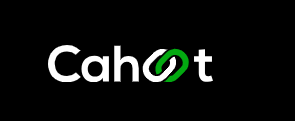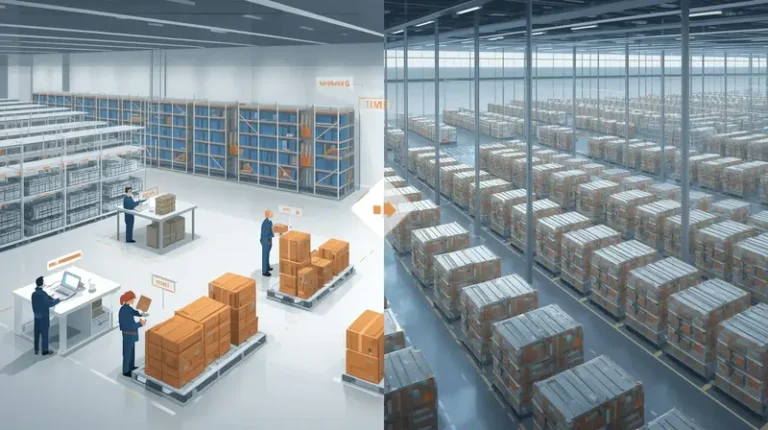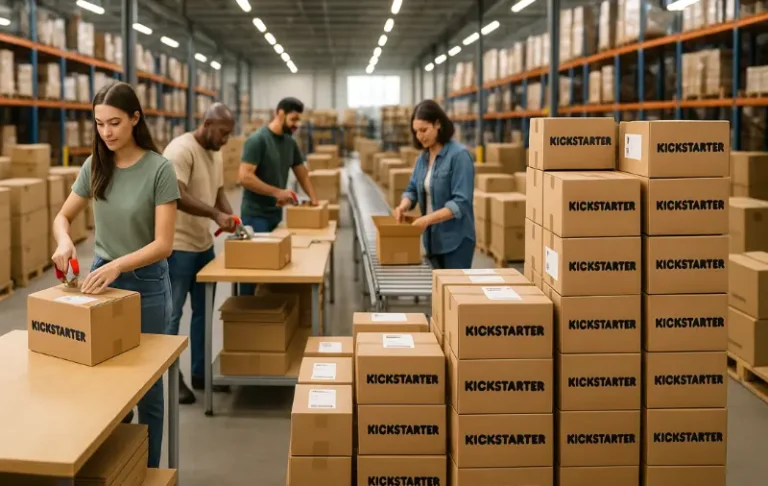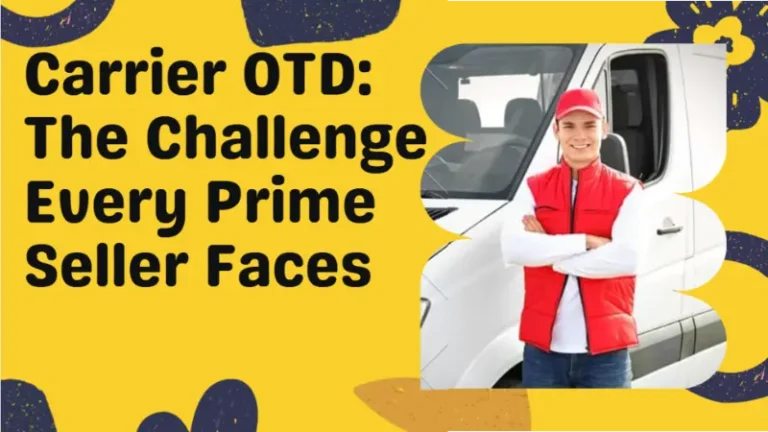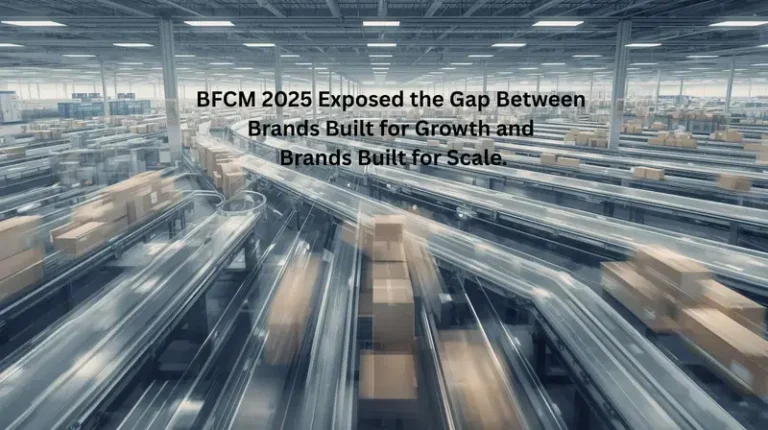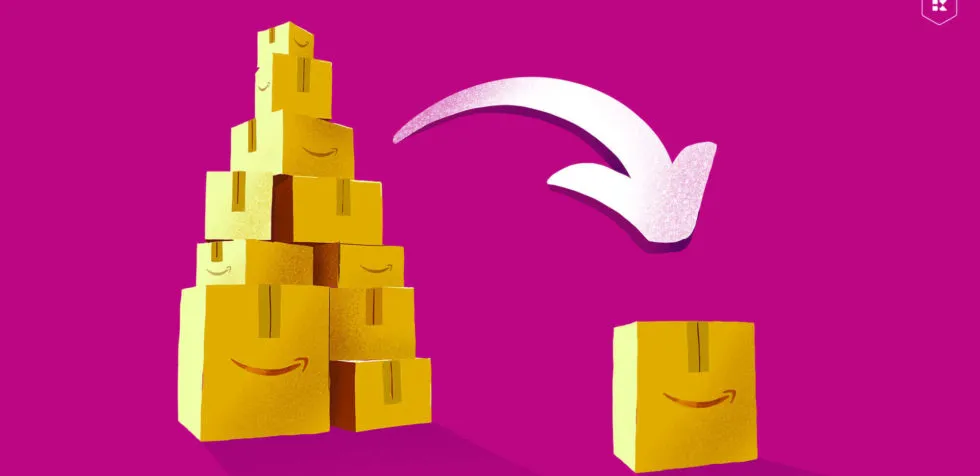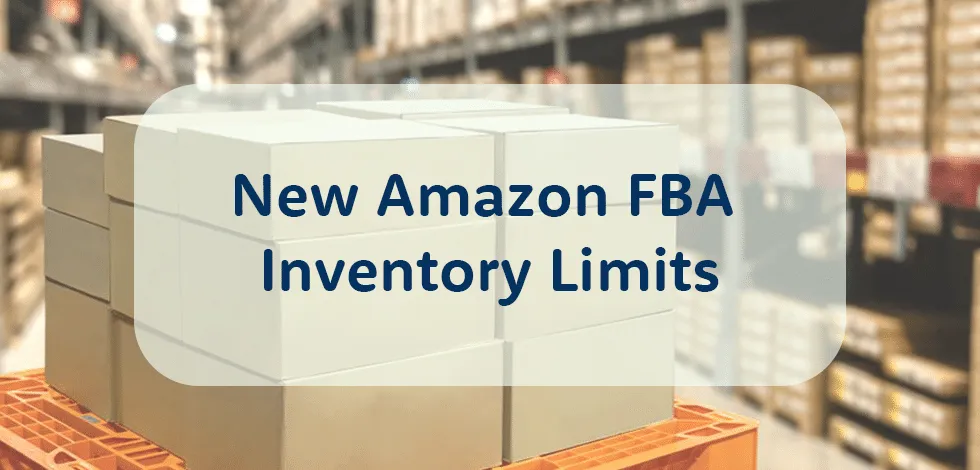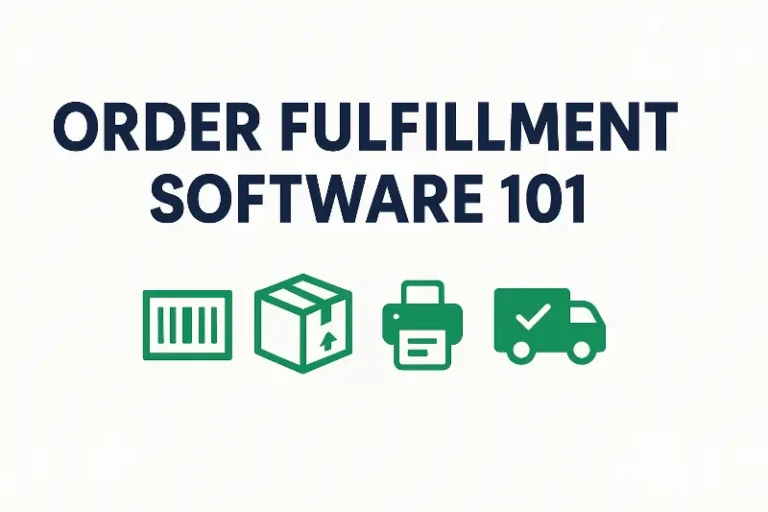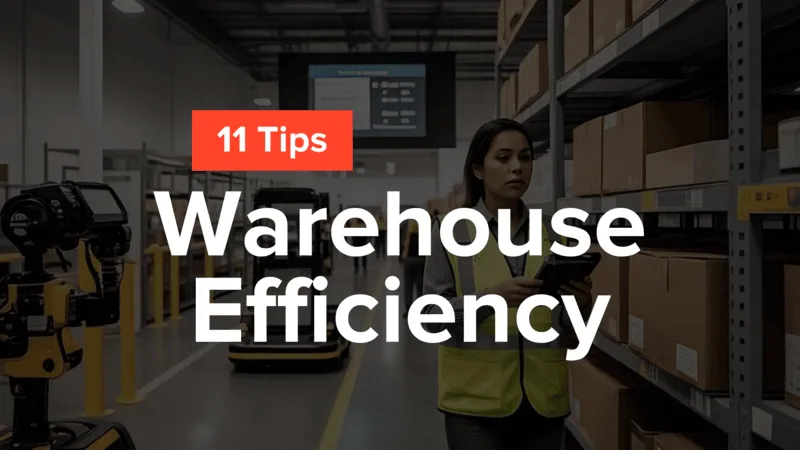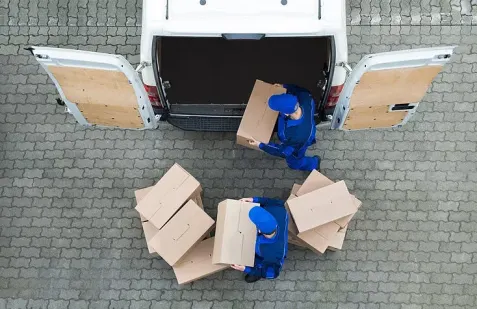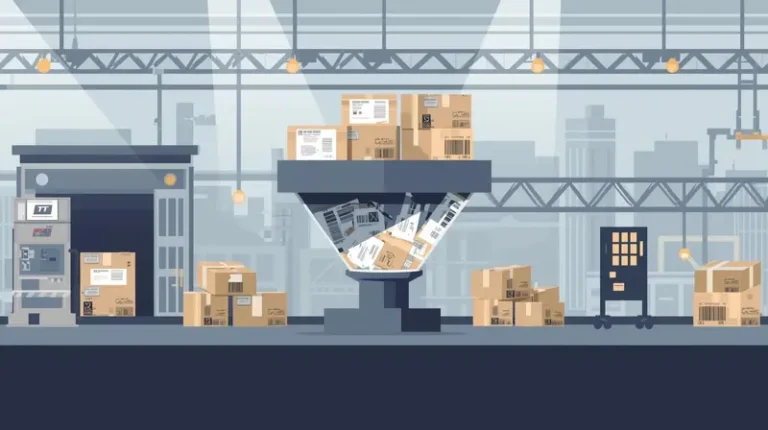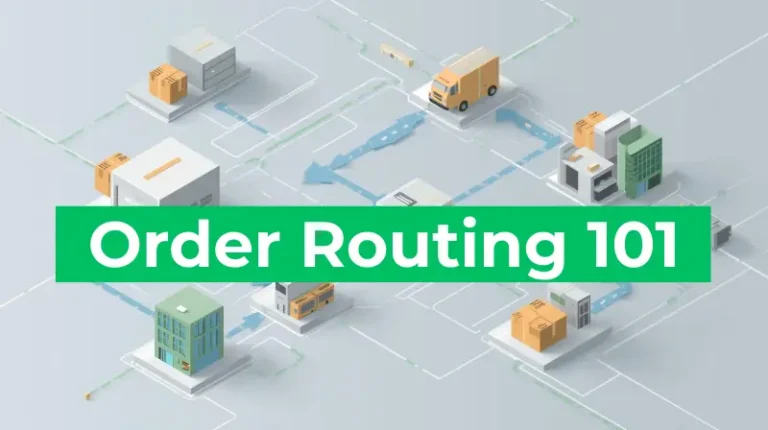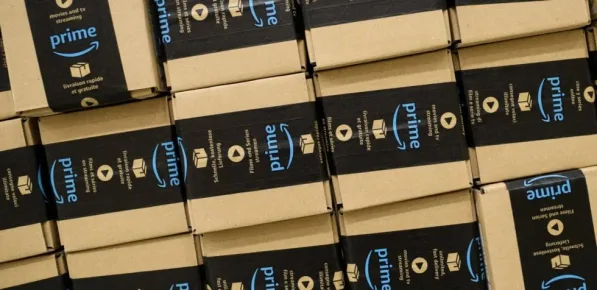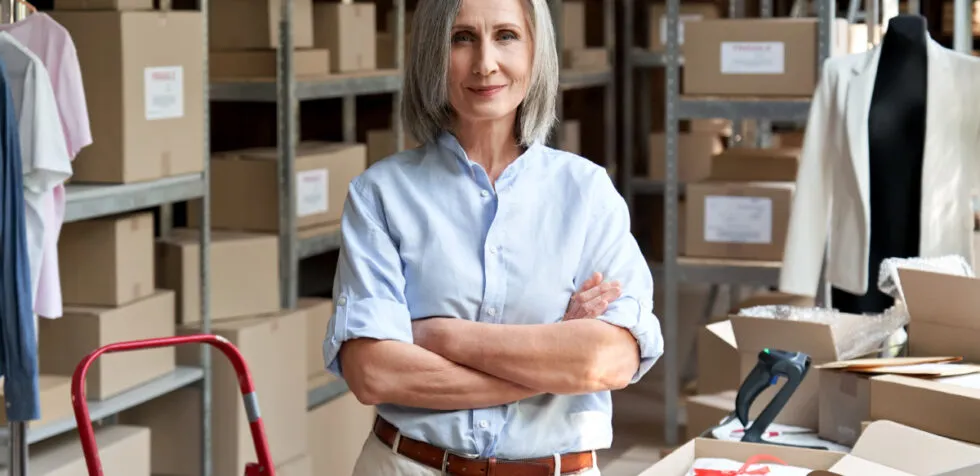Amazon’s E-Commerce Fulfillment Changes: Expert Insights and Free Tools for Sellers
In this article
 31 minutes
31 minutes
Podcast: How to Take Advantage of the Changes in Ecommerce Fulfillment – Cahoot
The Sellernomics podcast discusses e-commerce order fulfillment changes and offers free tools for Amazon sellers. Cahoot CEO, Manish Chowdhary, discusses how the pandemic affected Amazon’s order fulfillment strategy and how sellers can keep up with these changes. Amazon is focusing on profitability, so fees have increased for fulfillment, Fulfilled By Amazon (FBA), warehouse storage and removal, and the small and light order fulfillment program has moved from a weight-based to a dimensional weight pricing system. This change has caused concern for FBA sellers who rely on the program. Chowdhary offers tools to help ecommerce sellers track inventory, refunds, and automate their seller accounts. The podcast is sponsored by Getida, which offers $400 in free FBA reimbursements. The hosts, Rob Stanley and Lisa, provide insights and ask questions about order fulfillment changes for the benefit of their listeners.
Speaker 1:
Welcome to the Sellernomics podcast. In today’s special episode, we are going to share some great tools and software available to Amazon Sellers. Special thanks to our sponsor, Getida. Did you know you can get $400 in free FBA reimbursements at getida.com/sellernomics? Now it is time to show us what you got with your host, Rob Stanley.
Speaker 2:
Hey, everyone. Welcome to another great show on the Sellernomics on Show Us What You Got. We got a really good one today. I got Manish Chowdhary. He’s going to be coming on in just a minute from Cahoot, and we’re going to be doing a really cool thing, talking about how to take advantage of changes in e-commerce fulfillment. But real quick, I’m going to bring in the room Lisa, our amazing other host, Lisa.
Speaker 3:
Hi, everybody.
Speaker 2:
Hi, Lisa. So Lisa, this is a field you’re familiar with because you come from this whole area of order fulfillment. This will be an exciting one to have you a part of and obviously, an area that I am not super familiar with. So we’re going to lean on you for the questions for Manish when he gets in the room here. Let’s bring him in and let’s definitely have Manish enter and talk with. Hey, Manish. How you doing?
Speaker 4:
Hi, Rob. Pleasure to be here. Thanks for having me.
Speaker 2:
Absolutely, absolutely. Manish’s got a great presentation already lined up for us, so let’s jump right into it. Manish, why don’t you take it away? It’s time to show us what you got.
Speaker 4:
Thank you, Rob. Thank you, Lisa. Great to be here and thank you everybody for joining. Want to take you quickly through a little bit of what’s happening in the world of e-commerce fulfillment. By way of introduction, my name is Manish Chowdhary. I’m the founder and CEO of Cahoot. I’ve been involved with e-commerce for over two decades, founded and built one of the first e-commerce platforms out there way back in 2000, and then more recently founded and built the world’s first peer-to-peer order fulfillment services network. We help brands and retailers succeed through free and fast shipping. As we know today, half your shopping experience is your shipping experience. Just to give you a little bit of background as to what’s happened in the world of Amazon, Amazon went into overdrive mode on the fulfillment side when the pandemic hit. You know all remember when March of… Was it 2019 or when?
2020 when pandemic came in, and then most sellers could not send their products to Amazon because Amazon was focused on only essential goods. They were turning away sellers and that really led Amazon to really triple down. In fact, Amazon spent more in two years over the pandemic in terms of expanding their order fulfillment footprint than they did in the previous 18. By way of simple comparison, Amazon built 517 facilities in 2021, added over 150 million square feet of space, and then we heard in Q1 of last year when they announced their earnings that Amazon actually made a loss and they had overhired people in Q1, and that basically Amazon was focused on profitability. Amazon still wants to continue focusing more on profitability. And then we heard two rounds of fulfillment fee increases. One in January. This was announced earlier last year, fulfillment fees, FBA fees went up 2% to 12%, storage fees went up and the removal fees went up almost 100% and it came in two different tranches, basically.
In February 1 of 2022, already it was announced previously the FBA fees is going up. And why this is important is just to understand the background of where FBA is headed, where the world is headed. And then more recently, end of April, FBA announced this fuel surcharge or whatever you want to call it, inflation surcharge of 5% on top of whatever the order fulfillment fees were, what Amazon has already increased. So all of this is taking quite a bite out of the seller’s profits and something that the sellers need to pay close attention to. One big change, which sellers, some of you are familiar, some of you may might not be familiar, but it’s a really important change that happened in January of this year, the change to the small and light fulfillment program by FBA. Previously, it used to be if you are selling a small and light item, which is essentially this criteria, it has to be under $10.
The selling price, it cannot be more than 18 by 14 by eight, that’s on the longest side. The product could not be greater than 18 inches. And previously, as long as it was under three pounds, it qualified under the small and light program, but Amazon has gone and changed it from purely weight-based to a dimensional weight pricing and that has created a lot of stir, a lot of challenges for a lot of sellers, particularly the FBA sellers that rely on the small and light program. And just by way of example, if you look at this, the salt and pepper shakers, a four ounce item, previously, when dimensional weight pricing wasn’t in effect, you could ship it for $2.53. Now it’s $4.42. Almost 80% increase. You look at the Christmas ornament. It used to be nine-ounce item, but because of the dimension of the product, now it is using dimensional weight and now you’re going to pay $5.19.
Slash Your Fulfillment Costs by Up to 30%
Cut shipping expenses by 30% and boost profit with Cahoot's AI-optimized fulfillment services and modern tech —no overheads and no humans required!
I'm Interested in Saving Time and MoneySo just imagine, if you’re selling for $10 and $5.19 is just the FBA fee before the commission and everything else, that’s a big, big hit. And certain items that used to classify as small and light, for example, this marker set is clearly is no longer qualifies as small and light and has been moved to the standard category, which is now priced at $6.75. So all of this has very large material changes and if sellers are not already familiar, they should. FBA is great. This is the easiest way for Amazon sellers or online sellers to pretty much get in business. It is great if you’re selling small and light items. If you don’t sell a lot of multiples or bundles because they’re a pain, you need to prep them, and also if you don’t prep them, then of course, the pricing of that can get pretty out of control because the way FBA prices itself is based on the skewer, the ASIN, and if you sell multiples, you’ll pay twice as much.
And I’ve got some examples coming up so stick around. Receiving delays. I know that this is something that the sellers had a lot of trouble last year, especially in Q4. Long, long receiving delays. Things are a lot better now, but we are not out on the woodworks. There is still considerable delays that I hear from sellers almost every single day. And new product launches. Yes, Amazon moved from basically ASIN level inventory limits to an account level limit. So it has certainly eased the pain on inventory limits, but it’s not completely gone. IPI, the inventory performance index is still in place. And when you are thinking about adding a lot of new items or new product launches, whether it’s now or Q4 or back-to-school, you need to pay close attention to that because that can have an impact on your account health and your inventory restock limits. And also, if you’re selling on other channels like Walmart, Walmart clearly prohibits sellers from shipping the products from Amazon. Yes, they’ve been somewhat quiet about it, but that’s changing because Walmart is very focused on Walmart Fulfillment Services and they don’t want a package going out with prime branding to a Walmart customer. Yes, Amazon has a pilot program where they can do neutral branding, but majority of the items are still going in FBA boxes.
Speaker 2:
Hey, Manish. Quick question came in on this and I’m going to summarize it because it was kind of long. I don’t know if you just read recently, but there was a whole thing about some of the Amazon warehouses either closing or they stopped building them or something like that, which, just my personal opinion, it’s weird. They had this whole thing where they were limiting people shipping items in, they were having people take items out of stock, which I don’t know if they were doing that more for the quality of the items that were in their warehouses, but I remember at one point it was because they were out of warehouse space. So they start building all these warehouses. Now I’m reading, I think today I even read the article, too, about them actually closing or discontinuing some of these warehouses. Obviously, you don’t work at Amazon, but what’s your opinion on that? Because it seems like, “Hey, not enough space. Now we have too much space.” So it was weird. How do you think that might affect sellers?
Speaker 4:
Yeah, that’s a great question, Rob. Essentially, Amazon just recently announced the Q2, second quarter earnings, and at the end of first quarter, Amazon publicly admitted that they had excess capacity and they had decided to sublease. A lot of it is as many, many experts got it wrong that people overbuilt thinking that the pandemic growth is going to continue. You probably heard a couple of weeks ago Shopify laying off 10% of its workforce and likewise, Amazon had done two things. They had of course overbuilt in anticipation of higher demand and also Amazon’s Prime program, as you probably heard, a rollout of buy with Prime that would lead to greater demand and that the transition of the online growth will continue to grow at a pace that’s much higher than what we are expecting now after in the post-pandemic. And lastly, the biggest reason or contributor for Amazon shutting down some warehouses was excess labor capacity.
Amazon hired 14,000 additional workers or some 14,000 to 26,000 additional workers in Q1 and that was because of the Omicron virus, the variant that Amazon CFO, Brian Olsavsky, admitted that they had over-hired the people so they’re now back to normal levels in Q2. So some of those warehouses, they have shut down, however, I wouldn’t read too much into it. Amazon is such a large organization. Just because Amazon had a ton of excess capacity, there’s still plenty of excess capacity. The big picture for the sellers, what sellers need to be focused on is Amazon is going to continue focusing on profitability. They’re going to continue to raise rates as we’ve seen, so keep that in mind. And of course, having somebody like Getida on your side to find those reimbursements, find those missed savings is a big, big plus, especially if you’re spending 10%, 20% more. So overall that is the lay of the land, Rob. I don’t know if I answered your question.
Speaker 2:
No, that was perfect. That was perfect. Keep going. Thank you so much.
Speaker 4:
Thank you. Thank you. So FBA has been great for small and light as we all know, but if you look at this cables, great. $2.70 cents. It’s going to be a lot more expensive if you try to ship it yourself or use any third party logistics (3PL) company. Same thing with this, for example, the headphones. A 1.2 pounds small and light item, but look at this oversized dog bed. I think sellers, probably many of them, are misinformed, that FBS is always the cheapest option. In this case, as you can see, five-pound item, you could actually ship it for a lot less yourself. And also, not to mention the Q4 storage fees at Amazon is three times the regular storage fees and getting things in and out of Amazon during Q4 is very hard. So something to be aware of, something that you need to be focused on.
And also, one thing that a lot of sellers are probably not fully informed on is mixed cues orders. If you look at this example, if you’re selling socks, you could be selling anything. A pair of black socks and a pair of yellow socks, they’re two different SKUs. So you don’t get the benefit. It doesn’t really cost twice as much to ship the item, however, the way FBA pricing works is you will pay by the SKU, you’ll pay by the ASIN, by the unit. So it can get pretty expensive. And if you are using FBA for multichannel order fulfillment, let’s just take a quick example. You can see from the screen, it can really rack up. We did an analysis for another apparel brand and we could save them over $50,000 annually and not to mention not to deal with the limits and certainly, before counting the storage fee changes, Q4 surcharges.
Looking for a New 3PL? Start with this Free RFP Template
Cut weeks off your selection process. Avoid pitfalls. Get the only 3PL RFP checklist built for ecommerce brands, absolutely free.
Get My Free 3PL RFPSo if you’re selling four pairs of socks, that can make a big difference because it can take a nice bite out of your margin. If you are doing FBA multichannel fulfillment, it could be almost three times as expensive. Something that the sellers ought to be aware of. So as you’re selling on, say, Shopify or your own store or Walmart, and if you have apparel of these kind of SKU variations, you want to be aware of the cost implications. And I covered this earlier, that FBA receiving is still taking time. You could send by small parcel like a UPS, FedEx in small boxes, you can expect to receive them sooner, a five-day receiving generally speaking. But LTL receiving is still taking at least two weeks and this is, of course, we expect the holiday season to start early this year as it was last year. So you want to be mindful of that, that receiving delays are still. And items that are in transit, that are in the process of receiving also count towards your inventory restock limit.
So keep that in mind that the limit is calculated based on the items that are still in transit or in the process of receiving. Finally, I want to take you out of just the Amazon world and also talk about some of the recent developments. What’s happening in the world of fulfillment? The fulfillment war is heating up. April, just a couple of months ago, Amazon announced this Buy with Prime program. I’m not sure if Lisa, Rob, you’re familiar with, but this is a very popular or at least long-anticipated program that is still in beta. It’s by invitation only. It’s essentially extending your FBA, your prime membership to off Amazon channels. So if you are selling, let’s say, on WordPress or WooCommerce or your own customs store, like a big commerce store, you can now install this Buy with Prime button on the product page, on the checkout page.
And the Amazon Prime shopper one, they get that familiar badge that they’re familiar with, they get the date certain shippings that tells you right on the product page when your product will arrive and you get all the benefits of Amazon Prime. Free two-day shipping or without any minimum, free returns. And then when you log in, basically, your Amazon account credentials or Amazon account information will load up, all your preferences will show up. However, there’s a big challenge with this. While it might look very enticing and tantalizing to use it, but the whole purpose, if you’re doing DTC, most sellers that we talk to want to build a brand. They want to build and own that customer. They want to own the first party relationship and by introducing this Buy with Prime, you lose all of that because Amazon, of course, is not going to hand you all the customer data after the customer checks out because it’s still the Prime customer. Before I move on, Rob, Lisa, do you have anything that you want to add here or anything?
Speaker 3:
Yeah, I just wanted to get a little clarification around the Buy with Prime. So like you said, it’s invite only, it’s in beta right now and it sounds like it’s for current FBA sellers who have additional channels but they want to be able to fulfill with the same speed and have the credibility behind it. What opportunity, if any, is there for a,, let’s say, Shopify store owner who has a small and light product like the headphones or the cables you referenced before? What opportunity is there for them to use Buy With Prime if they don’t currently sell on Amazon? Is there any?
Speaker 4:
That’s a great question, Lisa. It is a by invitation only program right now. Amazon is beta testing this and they have initially invited mostly the existing FBA sellers that have an existing relationship with Amazon that are selling on Amazon, but they also sell elsewhere. So the only advice I have for non-FBA sellers and non-Amazon sellers is to join their waitlist and we hope that they’ll invite you soon. If you’ve been an FBA seller, then of course, your chances would be higher and as to when you’d be invited. But right now, Lisa, this is a by invitation only program and there’s not much more the seller can do except for joining the waitlist.
Speaker 3:
Got you. And I assume any of their inventory is going to be subject to IPI and weight and dimensions, minimums and things like that, even if they’re not currently selling on Amazon? If it’s in their warehouse, they’re going to have to abide by those guidelines, right?
Speaker 4:
Yeah, so this is still a very new program. There’s a very limited amount of information that is available to sellers and outsiders. Amazon is right now basically testing this with proven sellers and they are collecting feedback. They have been very reluctant in sharing a lot of information because they don’t want sellers to have any early impressions of how this would impact their IPI and others. So it’s too early to tell how this is going to affect, but clearly, Amazon building 517 new warehouses with excess capacity, it is part of them to acquire more customers and more inventory, but we don’t know as much. So I’m reluctant to provide advice that may or may not be accurate.
Speaker 3:
Got you. No worries there. We’ll all just have to see how it unfolds, I guess.
Speaker 4:
However, I’ve done a amazing webinar, actually. I spoke at a conference last month and there is a detailed information on Buy with Prime and how it impacts DTC sellers. So I’d encourage the viewers, if you’re interested in learning in depth, go to Cahoot.ai, go to the resources page and you’ll find my talk there and it goes into great detail about what the implications are and you’ll find some amazing information there.
Speaker 2:
Absolutely.
Speaker 4:
Cool. So moving on, of course, April, Amazon announced Buy with Prime. That really created shockwaves in the Shopify ecosystem. Shopify, as we know, they’ve been talking about this Shopify fulfillment services network since 2019, but I rarely speak to merchants who are actually using Shopify fulfillment services networks. For a lack of better word, it wasn’t going anywhere and as a result of this Amazon Buy with Prime announcement, they rushed and they acquired Deliver, which is one of the services that competes with Cahoot and that took place in late April, early May, I think. Shopify is going to pretty much rebrand that as a Shopify fulfillment services network and they call it Shop Promise, which is essentially the Shopify’s version of the Prime badge, which, of course, there is no consumer component, there is no membership so you don’t get your free Amazon videos or you don’t get free unlimited returns. They call it hassle-free returns, but it is basically a very similar version. You will check out using the Shopify account, you’ll basically will preload that information and then you qualify for two-day delivery.
Scale Faster with the World’s First Peer-to-Peer Fulfillment Network
Tap into a nationwide network of high-performance partner warehouses — expand capacity, cut shipping costs, and reach customers 1–2 days faster.
Explore Fulfillment NetworkBut again, even this is on waitlist. It’s by invitation only, so a Shopify merchant cannot just go and take advantage of it immediately. It remains to be seen how this is going to play out. And Walmart has announced that they’ve been pushing Walmart Fulfillment Services quite extensively. I spoke with the Walmart Head of Fulfillment. Previously, they were promoting other services like Deliver, but they’re now singularly focused on promoting Walmart Fulfillment Services and that’s why they’re cracking down on sellers that are trying to ship Walmart orders from Amazon, Amazon FBA. So I think they’re going to be doing more of that. And they’ve announced some partnerships with other technology providers that they will be building for next generation order fulfillment centers over the next three years that would cover 75% of the population and could speed up the… But there’s still a lot of limitations. Walmart, of course, do not ship international. There’s temperature control you cannot send, there’s a hazmat items are not acceptable. So there’s still a very long way to go.
By just way of comparison, Amazon built 517 fulfillment sortation distribution facilities in 2021 and it’s probably going to take Walmart three years to build four. So I don’t know how that is going to play out, but it’s certainly something that a lot of sellers are participating in because Walmart is also handing out some promotional discounts, but it’s going to be challenging but it remains to be seen. And just to touch on Buy with Prime, and I know we’re going to end the presentation shortly. Buy with Prime is a lot more than just fulfillment services. It’s essentially checkout. And as I shared, there is a excellent presentation for those who of you who are interested to go to our website, Cahoot.ai. Essentially, it’s wrapping Amazon Pay. Payments is one of the most lucrative pieces of the checkout process. It’s pure margin and that is what all these providers are interested in because they want you to checkout using their payment services.
Let’s say you put an item in the shopping cart and you abandon that cart, we know that Amazon Prime shoppers visit Amazon at least once a week, half of them buy at least once a week, and you’re talking 200 million members on the Amazon Prime network. So you bet if somebody abandons the cart, you will be targeted and retargeted on Amazon site. There’s a lot of implications for the brand because previously, you could set your own minimum for free shipping, like $49 or $69, but with Amazon Buy with Prime, it is basically there is no minimum. Average order value is going to go down. I call it the Trojan horse. It’s something that the merchants need to be fully aware of. If you’re an online seller, you’ve got Amazon FBA, which is great for Amazon sales, especially if you’re small and light. Walmart is pushing Walmart Fulfillment Services and Shopify is pushing Shopify fulfillment services network. Our belief is this creates a lot of challenge for the merchant because if you put yourself in the shoes of the seller, sellers don’t think about each fulfillment service as separate standalone.
They want to take care of business, they want to satisfy their customer with the least amount of hassle. So what it boils down to is distributed order fulfillment. It’s essentially, if you want to target two-day delivery, you need to have at least four strategic locations. If you want to target one-day guaranteed delivery using economical ground service, you need eight to nine strategic warehouses. That’s how all these services generally work. So if you break this down, it might look like rocket science, but it’s not. We at Cahoot do this because we support Amazon Prime customers, we support seller [inaudible 00:25:54] Prime program, so we know exactly how this works. You need to place your inventory smartly at the strategic locations. It is harder than you think because to determine what inventory should be placed where because you don’t want excess inventory, you don’t want too little inventory so on, then you need to promote this.
You need to enable the fast shipping badge so customers know what they’re getting because if you don’t enable, it’s like the tree falling on the forest. Nobody knows about it, you don’t get the credit. But when you do, you can improve your conversion by 50%. Then you need the technology that’s going to route the order to the right location. So you’re printing or choosing the most economical shipping service that gets there on time and gets there in a guaranteed fashion so customers are not disappointed because if you tell them two days and your products don’t arrive in two days, customers lose that trust. So that is very essential. And then finally, monitoring to make sure that the customer experience was indeed good, they received the package. And that is how a typical Amazon-like fulfillment works, which is what we do at Cahoot as well.
So I was talking about previously, if you are a merchant, if you’re a seller, right now, it’s really hard for a seller to send their inventory, manage restock levels, manage different conditions for each of the different requirements that FBA accepts this kind of ASIN or FN SKU, and then Walmart, you need the UPC. In case of Shopify, products that are considered oversized have to come in ready-to-ship fashion. All that is extremely taxing because sellers don’t think of that in that fashion. They want a holistic order fulfillment. They want to be able to manage all their fulfillment using a single simple solution. So what are the couple of ways you could do it? You could do it yourself, which would require you to sign leases, long-term leases. Warehouse rent is all-time high, folks, right now. Essentially it’s very, very hard to find space and labor.
Labor is super tight and then you need to sign a long-term lease, plus you need to do all the daily management, making sure everything is happening. That gets very risky and very expensive for most sellers to manage four different facilities and you have little visibility into the future. The other option is to contract with multiple 3PLs because majority of the 3PLs, two thirds of the 3PLs in the US are mom and pop operators, which means they have one to three facilities. So you’ll have to go and negotiate with several of them, east coast, west coast, maybe upper midwest in the Chicago area, then Dallas, Arizona, one of those, and perhaps one more. You have to then monitor that, route the order, you need some technology. There is no easy routing solution that’s available that does a fantastic job. It might send the order, but how will you recover if you find that the last unit that you thought was there is not there?
Remember, to enable Prime-like fulfillment, we need to ensure that each and every order is taken care of and there’s no room for apology to the customer because customer, that brand perception that Prime has created is because of that fanatical focus that Amazon has to ensure that they take care of their customers. A newer approach is to join a fulfillment services network such as Cahoot that has the technology that can do the routing. They also take care of the service level agreement to ensure that every order gets shipped out on time, is delivered on time and also, supporting both B2B and B2C across all channels because a lot of sellers sell wholesale, so you can’t exclude that. Of course, you can’t do wholesale economically through FBA because you don’t want to pay a per unit fee.
So these are some options, folks, you have, and I recommend that every seller should at least have an FBA backup because Amazon is great, FBA is awesome, but it’s not great for everything. No. The changes in fulfillment, as the topic rightly suggests, is that take advantage of the right channel, the right tool for the right job. And just by way of introduction of Cahoot, we are a nationwide one-day, two-day delivery network. We provide the industry’s highest fulfillment standards because we are one of the very few fulfillment services network that supports Amazon Seller Fulfilled Prime (SFP), same pricing all year long. There is no Q4 surcharges like Deliver, which is now part of Walmart Fulfillment Services, and we can get you started up and running in less than two weeks. And we can handle both B2B and B2C. We are very thankful to our clients for giving us some amazing reviews and ratings on all popular channels. So that’s all I have. I’m ready for questions. Rob, Lisa, back to you.
Speaker 2:
Yeah, that was great. Thank you.
Speaker 3:
That was fantastic. Thank you, Manish. That was wonderful. Like Rob alluded to earlier, I come from inventory supply chain. I won’t quite call it background. That was my introduction into the e-com world, I guess you can say, and I 100% agree. Either have redundancy to your FBA or just have the right solution for the right product, like you said. Obviously, it’s a great order fulfillment program, but it’s not necessarily the best fit for every kind of product. And also, just don’t put all of your eggs in one basket for anything really. COVID just opened our eyes to so many instances in which you wouldn’t want to have all of your eggs in one basket.
Speaker 2:
That is 100% true. That was great information. I learned a lot, actually, from that. Like I said, that’s not really my area of specialty, so that was really good information you shared there. If people are interested, I’m going to put up on the screen here, I want to make sure that everybody knows where to go. Head on over to Cahoot.ai or you can email sales@cahoot.ai for more information or if you have another question. Or you’re watching this video after we’ve done the live and you still had a question, you can do a couple things, either email Manish directly at Cahoot or sales@cahoot.ai, or post it in the comment area and I’ll make sure to send it over to Manish and ask the question and get it posted in the public comments also. Lots of good information. I may have to actually go back and rewatch that at some point because it was pretty in depth. That was really good.
Speaker 4:
Thank you, Rob. And just by way of audits and refunds, Cahoot, when we receive the item, we remeasure and reweigh every item and that information, if they’re using FBA and they supply that to Getida, then you could find more discrepancies because that’s one information that most sellers don’t have. So one of the other unintended benefits can be potentially additional refunds, possibly.
Speaker 2:
Yeah, no, you’re 100% right.
Speaker 3:
Absolutely.
Speaker 2:
Because Lisa and I both get asked this all the time we’re in at trade shows. “What about returns? What about returns?” And we’re like, “The returns don’t come to us. They don’t come to Getida. They come to you or maybe Manish and somebody has to obviously take pictures of it, document it.” We could obviously assist in trying to submit that paperwork and get a refund back, but that is not something that we offer because obviously, we don’t want to start opening warehouses and accepting returns like that. It would be too much. We already have a lot on our plate at Getida and lots going on, but be sure to go over to Cahoot.ai, check out Manish’s website. And again, if you guys have any questions, feel free to email sales@cahoot.ai or again, just post the question. Manish, great having you on the show. We had a few reschedules to get you here and everything, but I’m glad you came on. I’m glad you were able to share this information and thanks so much for showing us what you got. I really appreciate it.
Speaker 4:
Well, thank you, Rob, and thank you, Lisa, for having me. I really enjoyed being on this show, and again, if any sellers want to reach out, please reach out. I’d love to guide you. We could also help with savings analysis. This is something we do for some sellers, completely free of cost. There is no obligation. If you are selling standard oversized items and you’re just curious how much you could potentially save, you want to head out over to Cahoot.ai, fill out the contact us form, so at least you know what your options are.
Speaker 2:
Absolutely. Absolutely.
Speaker 3:
Fantastic.
Speaker 2:
Thanks again, Manish. Everybody, be sure to check out Cahoot.ai and join us again on the next show. Thank you.
Speaker 3:
Goodbye.
Speaker 1:
Thanks for joining us this week on the Sellernomics podcast. Special thanks to our sponsor, Getida. Did you know that Amazon probably owes you money for FBA reimbursements? Get $400 in free FBA reimbursements at getida.com/sellernomics. Be sure to join us again next week for more great tips on how to grow your business. And thanks again for listening.
Turn Returns Into New Revenue
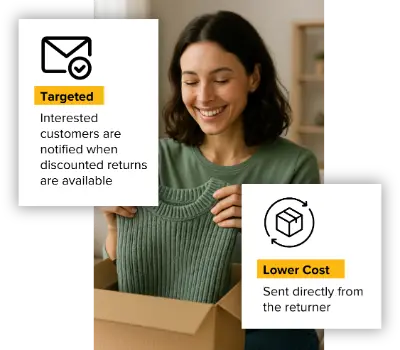
Profitable Order Fulfillment Strategies for Shopify Ecommerce
Listen to podcast here.
Podcast: Digital Marketing Intelligence for Shopify – Ask the Experts – Episode 94 – Manish Chowdhary (E-commerce Case Study) – RSS.com
This podcast focuses on providing insights and strategies for digital marketing and eCommerce on Shopify. The topic of the episode is profitable order fulfillment strategies, and the guest is an award-winning shipping logistics entrepreneur and eCommerce expert named Manish Chowdhary. He is the founder of Cahoot, the world’s first peer-to-peer order fulfillment services network, and holds 10 US patents for his inventions. The episode discusses how the right order fulfillment strategies can lead to faster growth, particularly in times of financial stress and inventory supply chain issues. Manish shares his insights and expertise on eCommerce strategy, warehouse logistics optimization, and supply chain issues.
Marissa Morgan:
Welcome to Digital Marketing Intelligence for Shopify, Ask the Experts. Our weekly podcast and video show, offers Shopify’s ecosystem of brand owners, store developers, app providers, investors and marketing agencies, insights from case studies and discussions, with marketing and eCommerce experts, grow faster with tips, tricks, and proven strategies, and learn what’s new in eCommerce digital marketing for 2022 and beyond.
Hello everybody and welcome to our next episode of Digital Marketing Intelligence for Shopify, Ask the Experts. I’m Marissa Morgan, I’ll be your show host today, and I’m also the business development manager for Ngagge. On behalf of myself and the entire team at Ngagge, I want to welcome you to today’s show. Today’s topic is all about profitable order fulfillment strategies and why right now they are the key to faster growth, especially during crazy financial times and all of these crazy inventory supply chain issues that we’re having across the globe. Our guest is an award-winning logistics entrepreneur. He is an eCommerce expert. He is the proud owner of more than, well, let me say, he’s got 10 patents, okay, that’s pretty incredible. And he’s also the founder of Cahoot, the world’s first peer-to-peer order fulfillment services network. What is that? Well, we’ll find out more about what that means in just a moment, when I introduce you to our special guest,
Before I do, of course, a quick word from our sponsor, Ngagge, before we get started. We’re excited to share that Ngagge recently launched our first app called SMS Messaging for Shopify Stores, in May of 2022. So that app is live right now, and what that app does is make it incredibly easy for Shopify store owners to not only build their customer lists faster, increase sales, but also save time with automations and create personalized campaigns to really improve the customer shopping experience. With our SMS messaging app, there is no code support bots, so it’s very easy to install and use, even if you don’t have a tech team. And right now with open rates of email kind of sitting around 20% or maybe even less, I mean, think about it, when’s the last time you opened a business email that was maybe a marketing email that you didn’t ask for? I mean, maybe you didn’t even open it. Right now the SMS open rate is 98%, maybe even higher.
So the likelihood that if you are not using SMS marketing right now, that you’re missing out on business is very, very high. So you can check out our app, Shopify SMS, Ngagge Shopify SMS at www.ngagge.com. That is www.ngagge.com, where you can sign up for a free 30-day trial of the app. And with that trial, you’ll also get 500 free SMS messages to start using right away so you can take the app for a test drive. So if you’re not using SMS, no time like the present to take advantage of the Ngagge SMS for Shopify Store app, which is available right now, ngagge.com.
Okay, it is time for me to introduce you to our special guest. He is joining us from New York. His name is Manish Chowdhary. And Manish’s incredible career in eCommerce started in his dorm room. He actually founded multiple industry leading companies while in his dorm room at the University of Bridgeport. By the way, that’s Connecticut, that’s where I’m from originally, so we have a common tie there. He is a logistics entrepreneur who also founded Cahoot, which I mentioned is the world’s first peer-to-peer order fulfillment services network for brands and retailers. His specialties include eCommerce strategy, business methods innovation, inventory supply chain and logistics optimization. And as I mentioned, he holds 10 US patents for his inventions and has also been featured in couple small publications like the New York Times, Forbes, International Retailer, and many other leading publications. He is a 40 under 40 competition winner and holds an honorary doctorate, which is the highest honor from his alma mater. Cahoot, his company, was recently named a Spring of 2020 SourceForge Top Performer and is also a five star rated company, not only on Amazon, but also Shopify, which is impressive.
And if this wasn’t impressive enough, he’s got an active social life as well. He’s an avid traveler and he’s actually traveled to more than half of all the Caribbean islands, which I find very impressive. I’m a big island lover myself. And he’s also a big fan of an IPA and is a big fan of trying different IPAs. So much fun. Manish, thank you so much for joining us today. We’re excited to have you as our guest expert on logistics and fulfillment and what that ultimately means for companies right now in a time of crazy financial stress and inventory supply chain issues, and of course what that means for happy customers. So thank you so much for joining us today.
Manish Chowdhary:
Marissa. Thank you so much for having me, and thank you for such a generous intro. I think it is more than I would ask, and I really appreciate all your audience listening to this show today. So thank you.
Marissa Morgan:
Oh, you’re so excited to have you. And you know what, that was only half of what I could have said for an intro for you. I had to take some time and leave out some things for time’s sake. But you have a very impressive background, not only in eCommerce, but obviously right now with logistics optimization and helping companies deliver obviously their goods and their services to the end user. But I want to ask you, because this is something new to me, what exactly is peer-to-peer order fulfillment? What does that mean?
Slash Your Fulfillment Costs by Up to 30%
Cut shipping expenses by 30% and boost profit with Cahoot's AI-optimized fulfillment services and modern tech —no overheads and no humans required!
I'm Interested in Saving Time and MoneyManish Chowdhary:
Yes, Marissa, peer-to-peer order fulfillment is a term that Cahoot has coined. Essentially it is about collaboration. It is brands and retailers collaborating and working together to make free and fast delivery affordable, no matter which channel you sell on. So on the Cahoot platform, brands and retailers that have warehouses of their own, that have excellent fulfillment metrics for their own orders, and if they have excess space in their warehouse, they have the opportunity, for the very first time, to join Cahoot as a fulfillment partner. And those are the warehouses Cahoot utilizes to place our client’s inventory, the seller’s inventory. And putting them all together, Cahoot has created this large nationwide network. Maybe an analogy might be something like an Airbnb, how Airbnb helped homeowners unlock new revenue stream by renting out their spare bedroom or their spare apartment. So Cahoot is making that same opportunity available for millions of sellers that have warehouses of their own.
So this is a unique opportunity and the advantage of all this to our sellers, to our clients, is lower cost, is because we take all those savings and pass it back to our clients. So that is what peer-to-peer collaboration is all about and peer-to-peer order fulfillment services network.
Marissa Morgan:
Well, that sounds like a win-win, just like I feel, that was a great analogy, Airbnb has been a huge win for property owners because it’s true, there’s probably a lot of entrepreneurs and businesses out there that have the space and don’t use all of it. So why not go ahead and outsource that space to other retailers, other brands, other companies that are looking for space and create almost this incredible network, like a spider web of opportunity for different brands to have their product in different regions.
Manish Chowdhary:
Yes. And this is particularly more relevant in today’s economy because industrial space or warehouses, space capacity is at all-time low. In fact, you cannot find warehouse space even if you wanted to. And as a result, the rent is at an all-time high. So if you were to go to a traditional 3PL, a traditional warehouse, you’re going to pay exorbitant fees. If you’re looking to rent a new warehouse space, you cannot find, or if you do find, you would have to Ngagge in a multi-year lease at a premium pricing. So just like, again, I’ll take the Airbnb example, during the 2008 recession when Airbnb got its start, people were looking for more affordable ways to make money, to stay and live more affordably or rent a room more affordably. And that’s what Cahoot is doing in the current inventory supply chain and the fulfillment world, which is a boon for both the people that are fulfillment partners for Cahoot, but more importantly, the sellers that are looking for relief.
Marissa Morgan:
Well, I know there’s a lot of benefits and I think we’ll talk about some of those benefits during our time together today. But again, it sounds like a win-win, it sounds like great way to also, I mean, do something good for the environment, because if you have products that are within the same state as the buyer, obviously your carbon footprint in getting those products to those buyers is going to be a lot less, less potentially trucks on the road. And this is exciting to me, I just feel like there’s so many benefits all around from the obviously experience of the buyer to get that product in a shorter amount of time, which we know Amazon has really conditioned all of us to expect things within two days really, is almost the expectation now. Would you agree?
Manish Chowdhary:
Yes. In fact, two days was the expectation two years ago, Marissa. In fact, most Amazon buyers expect, if you’re living in urban areas like Manhattan or New York or Los Angeles, shoppers expect the delivery to be next day for most items. In fact, Amazon itself has been raising the bar on fulfillment. So almost 40% of Amazon’s products are being delivered in one day now. So two day was-
Marissa Morgan:
Two day’s old news?
Manish Chowdhary:
Yeah, it’s delivered. So the world is moving even faster. I know it’s crazy, but the shoppers, like if I wanted wanted soccer goalposts for my kids birthday party on Saturday and it’s Friday and I don’t want to drive and go and pick up and spend two hours. And so people will make decisions, shoppers are making decisions based on the delivery promise, and it’s so important too. And that’s where a lot of Shopify sellers, a lot of any seller, on any market, on any channel, can win big using delivery as a strategic competitive advantage.
Marissa Morgan:
I love that. I love that. And I can totally understand this must get it the next day kind of mentality because a lot of us in general, humans in general, we tend to juggle, we tend to multitask, we tend to procrastinate. And most of us are not always planning weeks in advance for the things that we think we’ll need because maybe we don’t even know we need them yet. So I think as a culture, the last minute shopping world has also increased in size and the number of people kind of acting in that space because now we know we can get things last minute. And I think just a lot of our listeners are going, “Yeah, I’ve done that before, where I’m like, shoot, I need this tomorrow.”
So let’s just, for our audience watching the video show of today’s talk, I’m going to share a quick outline, for those of you listening on the podcast, we’ve doven into this, but I’m going to read through this for you. Again, today we’re talking about profitable fulfillment strategies and really why they’re the key to faster growth, especially right now during difficult financial times. We’re going to get into why you can’t rely on platform locked services like FBA. We’ll also have Manish walk us through how one to many solutions unlock new growth opportunities, increase economies of scale, and reduce complexity as well. And I know as we work through this talk together, Manish is going to share countless examples of different clients and what they’ve done and how they’ve connected to gain that edge through especially the peer-to-peer order fulfillment opportunity. So I guess, can you help me understand this concept of FBA, this platform lock fulfillment and what FBA is? Because that’s a term I’m not super for familiar with.
Manish Chowdhary:
Sure. FBA, as lot of our audience probably know, is fulfillment by Amazon. And we’re calling it platform locked fulfillment or platform locked services because FBA, for example, would give a different treatment to orders that originate from Amazon and how they fulfill them, and I’ll break this down for you, as opposed to orders from some other channel, because they’re playing favorites. Another example would be Walmart fulfillment services that is designed to help Walmart sellers succeed on Walmart alone. But when you think about the seller, most sellers, especially the Shopify sellers are selling on their DTC site and many of them are selling on marketplaces, both Amazon, Walmart, eBay, could be Target, could be Macy’s, but they’re also doing wholesale business. So if the merchant were to select a platform locked service, which means they need to now find other services or other order fulfillment solutions for their other needs, and that creates increased complexity, increased cost, and it is punitive because FBA, as you know, if you send your products to FBA, you get access to the Prime shopper, but it’s very difficult to get access to them if you don’t use FBA services.
So there are a lot of things that are happening and there is an antitrust case that’s pending as well, it’s called coupling. And I can take a pause here if you have questions, but I can keep breaking this down further into why this is not the best choice for the sellers, what are the advantages and what are some of the disadvantages.
Marissa Morgan:
No, I’m glad you broke that down for me. So FBA is fulfillment by Amazon, and as a customer, this helps me understand why sometimes when I’m shopping on Amazon, certain products can be shipped to me within that day or two timeframe, and then others are not. Even if it’s the same exact product or just from a different company, it’s because some of these companies have this agreement or Amazon actually holds this merchandise, versus other companies that may be selling through Amazon, but shipping themselves basically. You’re just helping me understand all the things that are happening behind the scenes, especially from a consumer perspective. So sounds like there’s benefits to FBA or some of these platform locked services, but then also there’s definitely some drawbacks as well.
Manish Chowdhary:
Yes, most definitely. I mean, there are some major benefits to platform locked services. For example, FBA, you get access to the Prime shopper. The minute you send your products to FBA, they are available to the Prime shopper, which is the most affluent, the high spenders on Amazon. And these are people that are over 150 million or over 100 million members in the US alone, which is probably one out of three. If you take out the kids and the elderly, I mean-
Looking for a New 3PL? Start with this Free RFP Template
Cut weeks off your selection process. Avoid pitfalls. Get the only 3PL RFP checklist built for ecommerce brands, absolutely free.
Get My Free 3PL RFPMarissa Morgan:
By the way, I call the Prime shoppers part of AA, and that’s Amazon addicts. I am a Prime shopper, but kind of by default, my husband’s more of a shopper than I am. But yes, I can feel the money that is spent through especially these Amazon Prime accounts. And when people shop at the top, they have the option as a Prime member to say, “Hey, I just want to see the Prime options,” which are the options that are probably using FBA.
Manish Chowdhary:
And many times I think Amazon only displays the Prime offers by default or Prime offers get priority over non-Prime offers. So if you, Marissa, are a Prime member and you log in with your Prime account on Amazon, the chances are that the products that you will see will be primarily Prime eligible products before you see non-Prime eligible. So because Amazon is all about having the customers having a great shopping experience, which means not only are you finding the wide selection of products, low prices, but also amazing delivery, which is one or two day, which has been one of the top advantages that Amazon has over other retailers like Walmart, Target, Macy’s, and that they continue to drive the flywheel through that delivery experience.
Marissa Morgan:
Now, I know you wanted to get into why you can’t rely, so obviously there’s benefits, but what is the main reason or reasons that you think eCommerce brands and people who are obviously shipping to customers, can’t just rely on the platform locked services?
Manish Chowdhary:
Several stories. Just was speaking with a large seller, this is one of the top Amazon sellers, and you would think that they would have an in with Amazon, they would be given preferential treatment, and these are people who are doing nine figures on Amazon. So not seven figures, not six figures, nine figures. And they wake up one day and they find that their inventory limit or how much inventory you can send to Amazon has been slashed to less than half. And that is a huge problem because Amazon just announced the second Prime Day, which is coming up in October 11 and 12. So now how are you going to manage and how are you going to … if your inventory limits are slashed, that means you cannot send all your products to Amazon. You cannot send them in enough quantities. And on top of that, Amazon is taking very long to receive these items.
So from the time you send the items to Amazon, it could take weeks for them to be received. And during that time, you cannot send them anything new. And if your product goes out of stock, let’s say you have five days of inventory and it’s going to take Amazon 10 days to receive it, after five days, your product goes out of stock, which means your seller rank drops, which means your inventory performance index, these are all Amazon terminologies, which is the way how Amazon keeps track of how much space or how much limit to allocate to each seller because sellers do not have unlimited quotas, so as to speak, they’re limited and restricted.
So now while there are many advantages, but if you’re a seller, now you are in a jam that if Amazon is such an important sales channel, you rely on that for your sales. You bought containers and containers of inventory that you’ve paid for from overseas, now your money is locked up and you can’t sell it on Amazon because you can’t get into FBA. And if you don’t get into FBA, you don’t get access to the Prime shopper, who are the ones who make most of the sales. So one of the challenges is that. There are many more challenges, I can talk about a few more. The second is multi-channel fulfillment. So let’s say you get all your inventory into Amazon, you’re selling on Shopify and you want to fulfill Shopify orders using your Amazon fulfillment services. Guess what? You’re going to pay up to 50% more to Amazon to fulfill your Shopify order because Shopify and Amazon are at war.
So Shopify went and acquired another order fulfillment provider called Deliver. So that’s the same thing, Shopify is not there to promote Amazon sales. So now if you start using Deliver, for example, which is a more recent acquisition, so this is a prediction, that they’re going to create policies that favor Shopify. So while things are good for the shopper, it is very difficult for the merchant to make money. And if the seller does not make money, seller does not profit, they’re not going to stay in business, and therefore they cannot innovate, they cannot bring the next product. So this becomes almost a self-fulfilling prophecy, that it was good to a point, and at some point it becomes bad and the sellers have to find other alternatives that are neutral. To ship an order, whether it comes from Amazon or Shopify or eBay, it’s the same effort, same everything, why should one cost more than the other?
Marissa Morgan:
And at the end of the day, it’s so sad to think that the only people that end up happy are the huge companies like Amazon and the consumer, because the middleman, which is the creator of the product or the inventor of the product or the brand founder, it’s like these people have put in so much work to create what they’ve created. So it’s so sad to think that the one person who ultimately gets the most screwed is the person who’s got the beautiful product to offer.
Manish Chowdhary:
That’s exactly it, and that is why we created Cahoot to be platform-agnostic. Same thing with Walmart. Walmart is favoring Walmart fulfillment services. So if you want to get on the fast track to get the two-day badge to attract the Walmart shopper, Walmart is doing, but it has tons of limitations, Walmart fulfillment services will not ship products internationally. So if you get an order from overseas, now you have to figure out another solution. In case of FBA, any product that’s oversized is very expensive to ship. So if you want to get access to the Prime shopper, it’s a problem. Q4, which is the holiday season, storage fees for FBA are three times as expensive as the rest of the year. So you can imagine, one, you can’t get your product, you’re lucky if you get it in, if you get it in and if you get it in late, if you miss out on sales, you’re going to pay Amazon three times.
While there are benefits, of course, it is not all disadvantaged, but these are the limitations, these are the challenges that sellers are facing and that’s why we created Cahoot to make it a level playing field. We want to think like the seller, what’s best for the seller? And if you want to do wholesale, we know most ecommerce brands want to also partner with other independent retail stores. For example, we have a client called Cali’s Books, they sell to Barnes & Noble, they sell to Nordstrom, so they want to send pallets and cases or books to these local bookstores. And that’s not something that FBA can do, that’s not something that WFS can do. So these are the challenges with platform locked services, because they were not designed to promote the seller, they were designed to promote the revenue for the platform.
Scale Faster with the World’s First Peer-to-Peer Fulfillment Network
Tap into a nationwide network of high-performance partner warehouses — expand capacity, cut shipping costs, and reach customers 1–2 days faster.
Explore Fulfillment NetworkMarissa Morgan:
Gosh, at the end of the day, something that we talked about before the show too, the end of the day, you said, and I’m going to quote you, I hope that’s okay, you said half of your shopping experience is your shipping experience. So what’s crazy is everything you’re talking about, the good, bad, and the ugly, all obviously affects the business, let’s say the eCommerce business. But the eCommerce business, especially the one that understands the consumer experience, the customer experience, that business is doing its best to make the best choices and put the best options in play so that ultimately the consumer has a great experience.
So it’s all intertwined, but it’s like everybody’s got their own, selfishly they have their own interests at play. And it’s kind of crazy to think that Amazon makes money, percentages off sales already, and you think that was the original business model, they make money by selling Joe’s product, they make a little cut. But now it’s gone way above that and they’ve now monopolized the entire process of selling and shipping, so that not only are they making a profit on the products themselves, but they’re making a ton more on housing, and like you said, getting the products in. It’s just insane to me. It’s insane. But now I know why Jeff Bezos has private jets and all this stuff, I mean, he’s raking in the dough, it’s insane.
Manish Chowdhary:
Well, you’ve forgotten the most biggest cash cow that Amazon has just created, advertising. Previously it was you get paid to sell the item on Amazon, that was great. Now in order to sell the item, you need to spend an insane amount of money on advertising.
Marissa Morgan:
To be the top featured product of that specific category for this many hours of the day or whatever. It’s insane.
Manish Chowdhary:
And then where’s the next area to get a larger share of the seller’s wallet, is the order fulfillment services. Because if I can create coupling, it’s called, which is what the US Antitrust is calling it, in their proposed bill, that it’s like Google favoring Google reviews over Yelp reviews for restaurants. But because you’re using the Google Chrome browser, you don’t have much of a choice because Google makes the decision on-
Marissa Morgan:
What you see.
Manish Chowdhary:
… restaurant reviews to show, so that is where there’s a problem. And especially the ecommerce brands on Shopify are looking to create a direct relationship with their customers, the DTC brands. So I spoke with a DTC brand this morning, that is into sustainability, they have these eco-friendly bags and so on, and they’re using FBA, but FBA uses plastic for all their shipment. So it goes against the ethos of the brand, that brand wants to sell eco-friendly product, but it comes loaded with plastic packaging and plastic tape, and that’s a big problem. But then because they make a lot of sale on Amazon, it’s very hard, very difficult for them to distance or move out of Amazon, then they lose the Prime shopper. So there’s some major challenges.
Marissa Morgan:
Well, I love that Cahoot is creating, let’s say, a more fair and better and economically ad advantageous way for people who have a product or a brand or eCommerce business, to be able to give the customer a great shipping experience and ultimately kind of stay out. It kind of just sounds like an awful rat race. It sounds sadly like a dictatorship. But tell us a little bit more about why shipping and order fulfillment is such a big part of the customer experience, because I know we were talking about that right before we hit record and started our show. You said it’s not just about the website anymore and the website being beautiful, and then you said that half your shopping experience is your shipping experience. Share a few thoughts you might have on that whole idea.
Manish Chowdhary:
Exactly right, Marissa, half your shopping experience is your shipping experience. I’ll take you down the customer journey. Customer comes to your website, they find your product, they love the product, got great pricing, and on that product page they decide to add the item to cart. What’s the next thing they’re thinking about? When will this product arrive? Let’s say I have a time bound shipment or just as we as humans are, we hate uncertainty, even if it’s going to take four weeks, tell me now, in the absence of clear, concise instruction, it is left for the shopper to guess, and that guessing leads to cart abandonment. And more importantly, let’s say some Shopify and other DTC brands will display four to seven days or three to five days.
Now it’s very difficult for the shopper to figure out when does the clock start? Four to seven days, is it four to seven business days? Is it four to seven calendar days? Is it starting tomorrow? Is it starting today? So the customer cannot make those, you’re asking the shopper to do too much math and they’re not willing and cart abandoned. So now let’s say you’ve done all that great stuff, you’ve got the shopper, they’ve even went through the checkout, now they’re thinking two to three days, then start putting all those customer inquiry, where’s my order, because customer has no visibility onto when the order will arrive. And that’s where some of the app that you have even, Ngagge, would be very, very effective in customer communication, because now the order has to be shipped and the merchant has to balance the shipping cost because customers are more and more used to free shipping, free and fast shipping.
So if your product is shipping from let’s say Florida to California, you’re paying the highest shipping rate for what we call zone eight, because as the furthest distance is traveling, or from Florida to Seattle, Washington. One, it’s going to take longer for the product to arrive and it’s going to cost the seller more because everything nowadays is based on the distance the package travels, the dimension of the packaging and the weight of the item. So you need to have your products widely distributed. And then because if you don’t do that, you have less, fewer chances of getting a positive review from the customer because if the product arrived later than they expected, order cancellation rate goes up and then certainly the customer delight element goes down so that the ecommerce brand recall value suffers. So there’s several reasons why the shipping and delivery experience is so paramount to the overall customer experience.
Marissa Morgan:
Well, I would love to know a little bit more also about this idea of peer-to-peer order fulfillment, because I know people are probably listening right now going, “Huh, I’ve only been using Shopify or I’ve been looking into …” So is Deliver currently active on Shopify?
Manish Chowdhary:
Yeah, Deliver is active. I mean, Shopify acquired them a few months ago.
Marissa Morgan:
Okay. So it is a way right now for people on Shopify to be fulfilling their orders through Shopify’s own kind of in-house process. But if someone’s at home right now saying, “Oh my goodness, this is the answer I’ve been looking for.” They ship all over the United States, maybe they have been using order fulfillment by Amazon and have been incurring extra fees and extra overhead and the stresses of it, peer-to-peer or as you said, one to many solutions obviously give more growth opportunities, allow businesses to keep more money in their pockets. So what is the first step for a company, whether they’re on Shopify or they’re on another platform, or maybe they are just operating through a website and it’s kind of a smaller in-house system right now, what is the first step to becoming a part of what Cahoot has created, this peer-to-peer order fulfillment process?
Manish Chowdhary:
Yes, Cahoot is the most merchant centric and merchant inclusive order fulfillment services solution on the market. So if you have a warehouse, we’ll use the Florida example, if you’re a merchant in Florida, you need to have your inventory distributed in a few different places. Let’s say you want to start small, you’re sending a lot of orders to California, you’re sending a lot of orders to Chicago or New York. Then Cahoot has the software and the technology where you don’t have to dismantle, you don’t have to get rid of your order fulfillment operations. You can keep your order fulfillment operations and only choose to outsource a portion of the orders that would be served, let’s say by Cahoot, in those regions. And that is very unique to Cahoot because that kind of technology is not accessible because it’s very complicated for merchants to now figure out which order should I fulfill, which order should Cahoot fulfill or which orders should somebody else fulfill.
So we don’t believe in rip and replace, we believe in letting the merchants pick the path that’s most comfortable, that they’re most comfortable with. And then soon they realize, oh wow, my California customers are getting their products faster. I’ve cut my shipping costs down by 20, 30%. And the Cahoot technology also helps them improve their shipping in their own warehouse because all that great innovation that we have, the 10 patents that you mentioned and so on, we also give the seller those tools to do that efficiently in their own warehouse. And of course for the people who want 100% outsourcing or they’re using a provider that they’re not happy with or they believe that they’re not happy with, you can come to Cahoot, fill out or contact us form, we can do a free savings analysis, we can evaluate your current costs and we can tell you how much money could Cahoot save you.
And that alone is very valuable because half the battle is knowing the power of information and power of what is out there, what can help my brand. And with Cahoot, if you go full-blown and you spread your inventory to Target, let’s say two-day delivery, now you turn on and make that promise on your website, be bold and say that on your website, “Hey, two-day guaranteed delivery,” watch your conversion rate soar. And then if you combine that with an SMS solution, like Ngagge, you’ve got one-two punch, and that’s what helps the sellers and the shoppers to get that DTC promise and the brand, that is that what an Amazon like experience is on every other channel, not only on Amazon.
Marissa Morgan:
I love this and I love the passion. We are in two different parts of the world right now. You’re in New York, I’m in Minnesota. I literally, I know you guys are listening on the podcast and you can’t see Manish, but I can feel the passion coming out of the screen. He’s beaming and you’re smiling from ear to ear. And as you were talking, by the way, I was listening to you and I pulled up the website, which I had looked at earlier, but right away when you were talking and I went to your website, boom, I happened to notice, because you were talking about Cali’s Books, but I saw this great testimonial from Cali’s Books and it said, “The most impressive part of working with Cahoot is the speed at which B2C orders are fulfilled and the consistently affordable shipping rates obtained.”
And then it says, “With our peer-to-peer network, you get faster, more reliable order fulfillment, at a lower cost and you can boost your conversions with one and two-day shipping,” and that you guys integrate with Amazon, Walmart, eBay, Wish, Shopify, BigCommerce, Facebook, so many. So I think this is a great place to kind of end our talk, because not only did you share obviously the importance of order fulfillment in a shopper’s experience, half your shopping experience is your shipping experience. I think that’s a takeaway that everybody can easily understand. But you shared examples of what works okay, benefits to it, some of the struggles that come along with it. But then ultimately, and I love it, you can totally tout your company and what you guys do because really you offer a wonderful way to navigate something that is very complex, but it doesn’t have to be.
Manish Chowdhary:
Right. And last but not least, an opportunity for ecommerce brands and retailers who have warehouses, to make money. How can we forget that? Because Cahoot is the only organized option they have to make money from their warehouse, and we’ve made it super-duper simple. So for any listeners who have a decent size warehouse, you’ve got great operations and people, this is an opportunity for you to make money. Fill out the contact us form on our website, cahoot.ai, and that may be another opportunity, a way for you to defray some of your cost, not only to elevate your order fulfillment and shopping experience, but also make some extra cash that you can put back in your business.
Marissa Morgan:
I love that. So the website to visit Cahoot and find out more, whether you have a warehouse that you’d love to rent out, basically rent out, lease out some space, share some space, or you have a product that you would love some help getting to your end users in a more timely, more eco-friendly, more economically savvy fashion, you want to be in cahoots with Cahoot, it’s www.cahoot.ai, so that’s www.cahoot.ai. And Manish, if our audience would like to connect with you, do I have your permission to share your LinkedIn as well?
Manish Chowdhary:
Absolutely. I love chatting with sellers, exchanging notes, because I learn so much by speaking to brand owners, operators, because they are in this every single day. So please connect with me on LinkedIn, I’m very active and I promise I will reply.
Marissa Morgan:
You can find him very simply by typing obviously linkedin.com/in/manish, M-A-N-I-S-H, -chowdhary, C-H-O-W-D-H-A-R-Y. And again, for those of you listening on the podcast, I’ll spell his name one more time for you. Manish, M-A-N-I-S-H, Chowdhary, C-H-O-W-D-H-A-R-Y. Manish, this has been, I was going to say, this has been such a great show, but I feel like … as much as I want to say, I feel like we’re just hitting the tip of the iceberg, I do feel like we really got through a lot in a short amount of time and you really helped me, and I know our audience as well, understand more just about the order fulfillment process in general, but the different avenues that are currently available, the pros and cons to each, and a really cool alternative that I think a lot of retailers and eCommerce businesses have not thought about, which is peer-to-peer order fulfillment. So thank you so much for sharing all of your insights with me today and our audience.
Manish Chowdhary:
Thank you, Marissa. Thanks again for having me.
Marissa Morgan:
Oh, it has been a pleasure and I want to congratulate you and Cahoot as well on all of the awards you’ve been winning, on the successes. I know you and I just connected on LinkedIn, so I’m going to definitely keep my eye on you, and I’m sure there’ll be more awards, more patents, and more fortune in your future. So congratulations. And for those of you listening right now, again, you’re probably listening to a podcast, I’m sitting face-to-face through a screen with Manish, the energy and the pleasantry and the joy in this man is just palpable. So check him out on LinkedIn, Manish Chowdhary, and check out www.cahoot.ai to find out how you can benefit from his, truly something you invented, which is peer-to-peer order fulfillment. Thank you again, Manish, and have a great day.
Manish Chowdhary:
Thank you.
Marissa Morgan:
That was an awesome show. I love guests that are passionate about what they do, and when you can feel the passion through a screen, that, to me, is just the coolest thing. So I have so much credit and respect for not only the 10 patents and all the experience that Manish has. He’s clearly a very smart man, starting businesses back in his dorm room at Bridgeport. That right there alone is pretty impressive. But when you pair that with someone who has such passion and joy of life, you really get a business owner that is not only savvy, but someone who is really empathetic with helping people and wanting to really make a mark and make a difference in the world, and especially in the world of eCommerce. So go Manish, go Cahoot. You guys, make sure you check out Manish Chowdhary on LinkedIn, connect with him, let them know you heard the show through the Ngagge podcast.
And also be sure to check out cahoot.ai, and that’s C-A-H-O-O-T, .ai. Whether you are an eCommerce brand looking for help with your order fulfillment process, maybe you even want some help just deciphering what you’re doing now, he said he often helps companies kind of work through what they’re doing now and give them a little screenshot of what that means. Or if you have warehouse space and you’re looking to capitalize on that and put a little extra money in your pockets or in your business, Cahoot can also help you do that. Awesome show. I want to thank you all so much for joining me and let you know that we always welcome you to send us referrals if you have someone you know that is a guest expert in the world of eCommerce and specifically eCommerce platforms like Shopify, Wix, WooCommerce.
If you’re interested in being on this show, you can connect with me and send an email to marissa.m@nggage.com. That’s M-A-R-I-S-S-A .M@ N-G-A-G-G-E .com. And of course, you can connect with me on LinkedIn and you can also connect with our company page on LinkedIn as well. For our company page, just look for the rainbow-colored cog wheel, connect with us there, and you can see all of our past shows as well. Speaking of shows, I do want to let you know that there’s an easy way to check out our podcasts, and you can do that by going to www.ngagge.com/podcast-library. That’s where you’ll find a complete library of all of our shows, with all of the guests. It’s a great place to go to if you have any questions about digital marketing, eCommerce platforms. We love to be your trusted source for digital marketing intelligence, especially when it comes to Shopify and eCommerce platform, so check it out. It is www.ngagge.com/podcast-library.
Thank you guys so much for joining me today. As always, I hope you have a wonderful rest of your day. We’re starting to get into the holiday season. I’m not sure when you’re listening to this podcast right now, but right now it is September, this show is dropping in September. So check back with us, we’ll be having shows every single week throughout the holidays and into the new year, with lots more to come in the world of digital marketing intelligence. And don’t forget to check out ngage.com for the Ngagge SMS for Shopify App free trial available with 500 free messages. Check it out and take advantage of all the opportunities that SMS messaging has for you and your ecommerce brand. You guys have a great day, and thanks again for joining me.

Turn Returns Into New Revenue

What To Do When Amazon FBA Won’t Accept Your Inventory
In this article
Practical Advice for Boosting Your IPI and What to Do When All Else Fails

For many, FBA’s latest change from ASI-level quantity limits to account-level quantity limits means a reduction of overall inventory storage levels – not good heading into Q4. Managing your Amazon inventory performance index score (IPI) has become more challenging than ever. No one knows whether further restrictions are coming, but if they are, don’t expect any advance notice from Amazon.
Amazon sellers that are overly dependent on FBA for fulfillment may find themselves disadvantaged heading into the Q4 ’21 holiday shopping season – which is expected to be the largest on record. Now is the time for sellers to understand all of their fulfillment options – and be ready to pivot before it’s too late.
Cahoot and Kaspien have teamed up to share insights on how to navigate the recent FBA inventory limits, and explore complementary fulfillment options like dropshipping and peer-to-peer eCommerce order fulfillment – that may just save your Q4 sales.
Here’s what we’ll cover in this How-To Webinar;
- Primer on Amazon FBA new inventory storage and restock limits
- Best practices for adapting to the new FBA restrictions
- Critical dates on 2021’s Q4 shipping calendar
- FBA Q4 surcharges, inventory challenges, and how to manage against them
- The pros and cons of various alternative fulfillment options
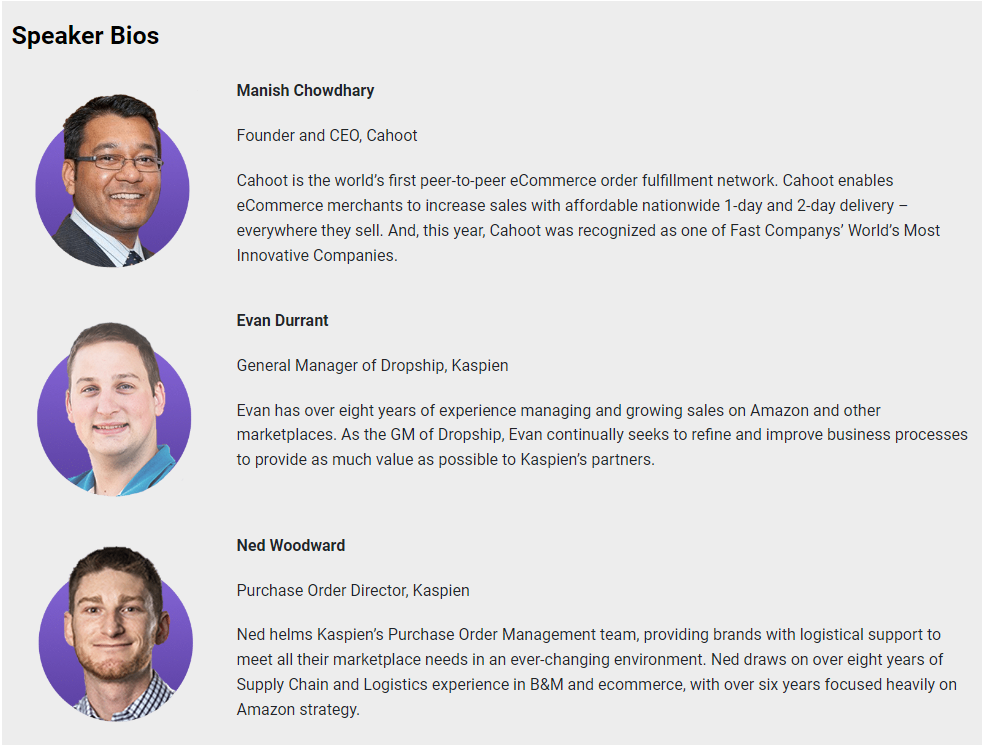

Turn Returns Into New Revenue

Amazon FBA Changes Quantity Limits Again!
In this article
 6 minutes
6 minutes
Here we go again with yet another tightening of Amazon FBA quantity limits. For many, this latest change means a reduction of overall account-level inventory limits. Most sellers will be affected by this change. But, considering that Amazon made this change just a few weeks before Prime Day ‘21, what will FBA do when space is really strained in Q4? For actionable advice on improving IPI scores and developing alternative fulfillment strategies that can mitigate risk and maximize Amazon sales in Q4 and beyond, check our article and on-demand webinar on How To Improve Your IPI Score & Maximize Amazon Sales
Sellers that are overly dependent on FBA for eCommerce order fulfillment may find themselves poorly positioned to take advantage of Amazon’s Q4 ‘21 sales opportunities that are expected to be the largest on record. Before it is too late, sellers should consider alternative or backup fulfillment strategies that will free them from this latest Amazon restriction or other changes likely to follow as we get closer to the holiday season. And, do not expect much advance notice from Amazon.
What Is Amazon’s New Inventory Restriction?
Amazon announced that effective April 22, 2021, FBA inventory limits are now set at the account-level and based on storage type rather than at the ASIN-level. In other words, there are no longer limits on the number of units that can be stored; however, there are new limits on the total volume of storage space available to hold those ASINs. Because this change impacts total storage limits, it also impacts restock limits. This change responds to seller feedback from a July 2020 ASIN-level quantity limit restriction driven by Covid-19 supply-chain challenges.
Amazon quantity limits, including this new account-level inventory restriction, are impacted by several factors. The two primary factors are the sellers’ Inventory Performance Index (IPI) score and Amazon FBA’s overall storage capacity. Amazon’s IPI score is essentially a measurement of inventory turnover; how efficiently sellers manage their FBA sell-through rates and inventory levels. The faster inventory moves through FBA, the higher the sellers’ IPI score. IPI scores take a hit when ASINs run out of stock or if inventory sits stagnant in FBA fulfillment centers, which leads to a reduction in sellers’ inventory limits. To make matters worse, Amazon has increased the IPI threshold multiple times throughout 2020 and 2021.
Slash Your Fulfillment Costs by Up to 30%
Cut shipping expenses by 30% and boost profit with Cahoot's AI-optimized fulfillment services and modern tech —no overheads and no humans required!
I'm Interested in Saving Time and MoneyWhy Has Amazon Restricted Inventory Limits?
62% of consumers start their search on Amazon, and Amazon saw a 40%+ growth in GMV. Consequently, Amazon fulfillment centers are bursting at the seams, and there’s no end in sight. Amazon currently has over 110 fulfillment centers in the US, but there is simply more inventory being sent to Amazon than they can handle.
What Does The New Inventory Restriction Mean for Sellers?

The intention was to give sellers more flexibility with inventory shipments. However, the response on seller forums is mixed. Sellers whose catalogs comprise primarily small and light items that are fast-moving all year round will be relatively unaffected by this change. On the other hand, sellers whose catalog is a mix of various weights and volumes and sellers whose sell-through rates ebb and flow throughout the year may need to make drastic changes. In addition, merchants that plan to launch new products may suffer, especially the newer sellers who do not have a proven track record on the Amazon marketplace.

Sellers who reach their inventory limit will no longer be able to stock up or send full container loads to Amazon at the beginning of the Q4 holiday shopping season or before a sales event like Amazon Prime Day. This is because additional shipments would be a policy violation. Instead, sellers will need to route shipments to 3PL warehouses and then send multiple just-in-time shipments to Amazon. As a result, these sellers will suffer significantly increased costs and greater complexities with their supply chain logistics.

Sellers that based their supply chain logistics around the earlier ASIN level limits are frustrated with yet another unilateral decision with little to no advance notice. Others are equally discontented by not being able to send more inventory for fast-moving ASINs. Here are a few comments from a seller forum that sum up the overall sentiment around this change.


What Can Sellers Do About The New FBA Inventory Restrictions?
Amazon’s repeated and unilateral changes to inventory restrictions have clearly frustrated many sellers. And as the saying goes, “Fool me once …”. So, whether it’s this latest restriction or others likely to follow in Q4, two things are clear;
- 63% of consumers start their search on Amazon, so regardless of this or any other new restrictions, your products must continue to be offered on Amazon.
- Merchants can’t sit idle. They must seek to understand their options now and be ready to quickly pivot to alternative fulfillment services if necessary to save Q4 sales.
Here’s a quick overview of Amazon FBA alternatives.
Switch to Fulfillment by Merchant (FBM)
As an Amazon seller, you can always switch to offering FBM. However, in addition to the logistics hassles of fulfilling all of your own orders, it is impossible to win the buy box with slow standard shipping, so the outcome would likely be a significant drop in sales. If sellers need to contract with new 3PLs, they could consider using a 3PL Request for Proposal Template to compare apples to apples.
Looking for a New 3PL? Start with this Free RFP Template
Cut weeks off your selection process. Avoid pitfalls. Get the only 3PL RFP checklist built for ecommerce brands, absolutely free.
Get My Free 3PL RFPShip Prime Offers Via Seller Fulfilled Prime (SFP)
If you are one of a handful of SFP merchants that have maintained Prime eligibility after the new amazon SFP requirements, you’re in good shape. If you have trouble scaling up, you can contract with multiple 3PLs or seek out an Amazon SFP Fulfillment Partner who is savvy with meeting Amazon SFP delivery speed metrics.
Join a Peer-to-Peer Fulfillment Network
An innovative and affordable alternative to working with 3PLs is outsourcing fulfillment to a peer-to-peer (P2P) e-commerce order fulfillment network. Like FBA, this model enables members to offer nationwide 1-day or 2-day delivery, in addition to the standard economy delivery. A P2P network comprises highly experienced and proven sellers who offer up existing space and resources to provide order fulfillment to other merchants. As a result, costs are generally lower than what you get with a 3PL fulfillment center, and multi-channel sales are the norm. A P2P network can be a good option whether or not the merchant has warehouses of their own. In addition, merchants with excess warehouse space and fulfillment capacity can tap a new revenue stream by fulfilling orders for others.

Turn Returns Into New Revenue

How to Successfully Offer a One-Day Shipping Program
Amazon Prime customers ordered billions of items with free one-day shipping in 2019. With 6.5 billion packages delivered in 2019, one-day delivery already makes up for 15% of Amazon’s total volume. This is impressive given that this program launched just ten months ago.
Amazon has been a pioneer in setting new customer expectations. Online shoppers weren’t really asking for free two-day delivery until Amazon made it available as part of its Prime membership in February 2005‑—that changed the online world forever. Today customers expect free two-day shipping on all their online purchases anywhere.
Amazon is at it again and now getting customers addicted to free one-day shipping. If you are a third-party seller, you too now must adapt to offering free one-day delivery if you wish to maintain high visibility, especially on marketplaces. It won’t be long before Amazon will prioritize two-day shipping offers organically over the others when it comes to buy box occupancy. Without one-day shipping offers, you might also have to spend more on ads in order to drive traffic to your listings. So getting your ducks in a row now will pay dividends soon besides contributing to more sales now.
It’s, however, no surprise that offering one-day shipping is both very expensive and stressful, given the high performance standards demanded by Amazon. Where there are challenges, there are opportunities. This is one such opportunity that growth-minded Sellers can capitalize on today before the others catch on the bandwagon.
Operational Excellence
Offering a successful one-day shipping program requires operational excellence. Without a reliable order fulfillment team and the right technology, it will be difficult to achieve the metrics required for the program: 99% on-time shipment rate, 95% on-time delivery rate, and <1.5% cancellation rate.
Below are some best practices we’ve learned at Cahoot that will help you prepare to offer one-day shipping:
Get ecommerce orders out on time
One-day shipping means all orders received before 2 PM on a business day must ship out the same day. Pay close attention to the following:
- Thoughtful storage strategy. Keep in mind that picking staff would spend most of their time walking through the warehouse, and a well-thought-out storage strategy would go a long way in improving operational efficiency. It is good practice to segment products and store them separately based on popularity and affinity. Don’t forget to regularly audit this because demands may shift due to product life cycle and seasonality.
- Efficient Picking Methods. Picking is a crucial step in the order fulfillment operation, and errors in picking would result in a lot of wasted time. Clearly marked bins for different SKUs and automated picking can improve the accuracy tremendously.
- Automated Label Printing. With little time to process orders especially towards the cutoff times, it becomes paramount to generate the best shipping labels automatically from your shipping software. Manually comparing services and carriers is prone to human errors and takes away precious time that can be spent elsewhere.
- Properly trained staff. It is imperative to make sure workers (especially seasonal staff) can navigate your warehouse quickly, safely and pick-and-pack accurately. You can start the new workers with standard orders as they improve their speed and performance before fulfilling one-day orders.
Slash Your Fulfillment Costs by Up to 30%
Cut shipping expenses by 30% and boost profit with Cahoot's AI-optimized fulfillment services and modern tech —no overheads and no humans required!
I'm Interested in Saving Time and MoneyDeliver orders on time
Below are some pitfalls to avoid in the order fulfillment process that delay package arrivals:
- Address verification and label quality. Having correct address down to the zip code +4 including “floor” or “suite” where applicable, makes a difference. Make sure your printed labels are clear, bold, and easy to read and not faded or dull (may happen to laser printers).
- No distinct sounds and smells. Packages with odd smells and sounds will get pulled aside during sorting at the carrier facilities for further inspections. While packing make sure to seal scented products properly and to turn off items or toys that make noises.
- Pick the right carrier and service. Lastly, make sure the carrier you’ve selected for 1-day orders has an excellent record of on-time delivery. A cheap but questionable service is not suitable for one-day shipping because you’ll be penalized heavily for late deliveries.
Maintain a low order cancellation rate
Having orders with no items to fulfill them due to inventory issues can force you to cancel an order, which will hurt your performance metrics. To improve inventory accuracy and visibility, implement a Warehouse Management System (WMS) and/or an Order Management System (OMS) and do not rely on human-managed spreadsheets.
Make one-day delivery profitable nationwide
There are limitations to having a single order fulfillment center for one-day shipping. A guaranteed next-day express shipping service is four times as expensive than the economical ground shipping. Unless you skyrocket your retail price accordingly, you won’t be able to make money off the transaction.
The simplest way to expand your order fulfillment nationwide is through outsourcing. There are marketplace-owned services like Amazon FBA and Shopify Fulfillment Network, which offer good rates nationwide, but charge extra for one-day orders. There are also third-party logistics (3PL) providers that offer nationwide reach but typically require minimum-commitment contracts and upfront fees. Many 3PLs do not have the ability to support all the Amazon Seller Fulfilled Prime requirements. Outsourcing order fulfillment could also make it difficult to maintain your hard-earned negotiated carrier rates because most providers like to use their own accounts for shipping for the mark-up.
A new option for offering one-day shipping nationwide is to use a peer-to-peer order fulfillment network like Cahoot, where top-rated sellers collaborate by pooling their resources to offer one-day and two-day shipping at the price of ground shipping or less. Cahoot offers the most economical way for brands and retailers to offer super fast shipping to its customers on all sales channels without sacrificing their profit margins.

Turn Returns Into New Revenue

Maximizing Warehouse Efficiency: 11 Essential Strategies for Success
In this article
 9 minutes
9 minutes
- How to Measure Warehouse Efficiency
- Optimizing Warehouse Layout and Traffic Flow
- Implementing Advanced Inventory Management Systems for Warehouse Operations
- Adopting Automation and Robotics
- Enhancing Employee Training and Engagement
- Utilizing Data Analytics for Continuous Improvement
- Implementing Lean Inventory Practices
- Enhancing Safety Measures
- Regular Maintenance of Equipment
- Streamlining Communication Channels
- Customizing Storage Solutions
- Conclusion
- Frequently Asked Questions
Efficiency is the backbone of successful warehouse operations. As businesses grow and consumer demands evolve, warehouses must continually refine their processes to stay competitive. Whether it’s optimizing layouts, integrating automation, or enhancing employee training, each improvement contributes to a smoother, faster, and more cost-effective operation. By implementing strategic measures, warehouses can maximize their potential, reduce waste, and improve overall productivity. This article explores a range of strategies to achieve a highly efficient warehouse.
1. How to Measure Warehouse Efficiency
It is absolutely necessary for warehouses to find ways to measure efficiency and identify areas for improvement. Common key performance indicators (KPIs) such as inventory turnover, order cycle time, and perfect order rate can be used to measure warehouse efficiency.
Inventory turnover indicates how often inventory is sold and replaced over a period, reflecting the effectiveness of inventory management, while order cycle time measures the time taken from order placement to delivery, highlighting the speed of warehouse operations. The perfect order rate tracks the percentage of orders delivered without errors.
In addition to those metrics, warehouse managers can use metrics such as storage capacity utilization, labor productivity, and equipment utilization to measure the efficiency of specific aspects of their business. By regularly reviewing these KPIs, warehouse managers can pinpoint inefficiencies and implement targeted improvements to optimize warehouse operations.
2. Optimizing Warehouse Layout and Traffic Flow
A warehouse’s layout can significantly improve or significantly harm efficiency. Optimizing existing warehouse space with a well-designed floor plan can prevent bottlenecks, reduce excessive travel time, and make it easier to locate products. By optimizing warehouse space, businesses can reduce unnecessary movement and streamline workflows.
One effective approach is to position high-demand items closer to packing and shipping areas. This ensures that frequently picked products are easily accessible, reducing the time employees spend retrieving them. Categorizing products based on size and weight also enhances picking speed and accuracy.
Another key consideration is the design of pathways. Wide, clearly marked aisles prevent congestion and allow for the smooth movement of personnel and equipment, such as forklifts and pallet jacks. Regularly reassessing the layout based on inventory trends and operational needs ensures that the warehouse remains adaptable to changes in demand.
Slash Your Fulfillment Costs by Up to 30%
Cut shipping expenses by 30% and boost profit with Cahoot's AI-optimized fulfillment services and modern tech —no overheads and no humans required!
I'm Interested in Saving Time and Money3. Implementing Advanced Inventory Management Systems for Warehouse Operations
Managing inventory efficiently is essential for preventing overstocking, stockouts, and misplacement of goods. Advanced inventory management systems (IMS) provide real-time tracking and visibility, helping warehouses maintain optimal stock levels and optimize warehouse efficiency through the use of warehouse management systems (WMS).
Modern IMS solutions incorporate barcode scanning and RFID technology to accurately track inventory movement. These tools reduce human errors, improve order accuracy, and minimize delays caused by misplaced items. Additionally, cloud-based inventory management allows for seamless integration with other business systems, providing instant updates on stock levels, supplier shipments, and order processing.
Automating inventory tracking also enables better demand forecasting. By analyzing historical sales data and market trends, warehouses can anticipate demand fluctuations and adjust inventory levels accordingly. This prevents excess stock from occupying valuable storage space while ensuring that popular products are readily available.
4. Adopting Automation and Robotics
Automation is transforming the warehousing industry by increasing efficiency, accuracy, and speed. Implementing automated solutions reduces reliance on manual labor for repetitive tasks, allowing employees to focus on more complex responsibilities.
Automated guided vehicles (AGVs) and conveyor systems streamline material handling by transporting goods efficiently throughout the warehouse. Robotics, such as automated picking and sorting systems, further enhance productivity by reducing errors and accelerating order fulfillment.
While the initial investment in automation can be significant, the long-term benefits—such as reduced labor costs, increased processing speed, and improved accuracy—justify the expense. Additionally, integrating warehouse management systems (WMS) with automation ensures seamless coordination between various operational processes, further optimizing efficiency.
5. Enhancing Employee Training and Engagement
Even with advanced technology, human employees remain (and will remain) a crucial element of a well-managed warehouse operation. Well-trained and motivated staff contribute significantly to streamlined operations and improved accuracy. Regular training programs ensure that employees are proficient in using warehouse technology, safety protocols, and best practices.
Engagement is equally important. Incentivizing employees with performance-based rewards encourages efficiency and accuracy. Open communication channels, feedback mechanisms, and a positive work environment foster a sense of ownership among workers, increasing productivity and reducing turnover rates.
6. Utilizing Data Analytics for Continuous Improvement
Data-driven decision-making is a powerful tool for warehouse optimization. By analyzing key performance indicators (KPIs) and evaluating and streamlining warehouse processes, businesses can identify inefficiencies and make informed improvements.
Metrics such as order accuracy rates, picking and packing times, and inventory turnover ratios provide insights into operational strengths and weaknesses. Predictive analytics can also enhance efficiency by anticipating demand patterns, optimizing workforce allocation, and minimizing waste. By leveraging data analytics, warehouses can continuously refine their processes and maintain a competitive edge.
Looking for a New 3PL? Start with this Free RFP Template
Cut weeks off your selection process. Avoid pitfalls. Get the only 3PL RFP checklist built for ecommerce brands, absolutely free.
Get My Free 3PL RFP7. Implementing Lean Inventory Practices
Adopting lean inventory management principles helps minimize waste and maximize resource utilization. The Just-in-Time (JIT) inventory system is a popular lean approach that ensures stock arrives only when needed, reducing storage costs and excess inventory. Implementing JIT requires strong supplier relationships and precise demand forecasting to avoid stockouts.
Lean inventory practices emphasize efficiency in every aspect of warehouse management, from procurement to fulfillment. By maintaining optimal stock levels and eliminating unnecessary storage, warehouses can reduce costs while improving service levels.
8. Enhancing Safety Measures
A safe warehouse is an efficient warehouse. Aside from their toll on personal health, workplace injuries and accidents lead to downtime, decreased productivity, and increased operational costs. Prioritizing safety measures ensures a secure working environment and smooth operations.
Regular safety training, clear signage, and well-maintained equipment help prevent accidents. Implementing ergonomic workstations reduces strain-related injuries among employees. Additionally, enforcing proper safety protocols for operating machinery, handling hazardous materials, and lifting heavy objects minimizes risks.
Investing in safety not only protects employees but also enhances overall efficiency by preventing disruptions caused by workplace incidents. A culture of safety encourages employees to adhere to best practices, creating a more productive work environment.
9. Regular Maintenance of Equipment
Warehouse equipment plays a vital role in daily operations, and its reliability is crucial for efficiency. Regular maintenance prevents unexpected breakdowns that can disrupt workflows and delay order fulfillment.
A preventive maintenance program ensures that forklifts, conveyor belts, and other machinery remain in optimal working condition. Scheduling routine inspections, replacing worn-out components, and addressing minor issues before they escalate prolong the lifespan of equipment and reduce downtime.
Additionally, maintaining accurate records of maintenance activities allows managers to track equipment performance and plan for necessary upgrades or replacements. A proactive approach to maintenance keeps warehouse operations running smoothly and efficiently.
10. Streamlining Communication Channels
Effective communication is the backbone of a well-coordinated warehouse. Miscommunication can lead to errors, delays, and inefficiencies, making it essential to establish clear communication channels between employees and departments.
Implementing communication tools such as warehouse management software (WMS) with real-time messaging features enhances coordination. Regular team meetings ensure that staff are aligned on operational goals, workflow changes, and performance expectations.
Encouraging an open-door policy where employees can voice concerns and suggest improvements fosters collaboration and innovation. By maintaining clear and transparent communication, warehouses can minimize misunderstandings and enhance overall productivity.
Scale Faster with the World’s First Peer-to-Peer Fulfillment Network
Tap into a nationwide network of high-performance partner warehouses — expand capacity, cut shipping costs, and reach customers 1–2 days faster.
Explore Fulfillment Network11. Customizing Storage Solutions
Optimizing storage systems improves space utilization and accessibility, leading to more efficient warehouse operations. Customizable storage solutions cater to the specific needs of different products, enhancing organization and retrieval speed.
Adjustable shelving, modular racking, and vertical storage units maximize available space while ensuring easy access to items. Implementing clear labeling systems further streamlines picking and stocking processes. In addition, regularly assessing storage requirements and reconfiguring layouts based on inventory trends helps warehouses maintain efficiency. Customizing storage solutions to fit the business’s needs prevents wasted space and enhances operational flow.
Conclusion
Improving warehouse efficiency requires a combination of strategic planning, technological integration, and workforce optimization. By continuously evaluating and refining processes, warehouses can achieve greater productivity, reduce costs, and enhance customer satisfaction. The key to success lies in embracing innovation, fostering a culture of efficiency, and staying adaptable to industry changes. With a commitment to continuous improvement, warehouses can position themselves as leaders in operational excellence.
Frequently Asked Questions
What are some cost-effective ways small warehouses can improve efficiency without investing in expensive automation?
Small warehouses can enhance efficiency by optimizing their layout to reduce unnecessary movement, implementing lean inventory practices to minimize waste, and utilizing affordable inventory management software to track stock levels more accurately. Training employees to follow standardized workflows and adopting basic automation tools, such as barcode scanners, can also help improve speed and accuracy. Additionally, regularly analyzing key performance metrics can help small warehouses identify inefficiencies and make strategic improvements without requiring a large financial investment.
What are the biggest challenges warehouses face when trying to implement new efficiency strategies?
One of the most common challenges is employee resistance to change, as new processes or technology may require additional training and adaptation. High upfront costs for automation and technology upgrades can also be a barrier, especially for smaller operations. Furthermore, integrating new systems with existing workflows can be complex and time-consuming, potentially causing temporary disruptions. To overcome these obstacles, warehouses should prioritize phased implementation, provide comprehensive training, and ensure clear communication about the benefits of the changes to gain employee buy-in.
What strategies can warehouses use to manage seasonal demand fluctuations?
Seasonal demand can create significant operational challenges, including stock shortages, overstocking, and increased labor costs due to fluctuating order volumes. Warehouses can prepare by analyzing historical sales data to anticipate demand spikes and adjust inventory levels accordingly. Implementing flexible storage solutions, such as temporary shelving or rented warehouse space, can help accommodate excess stock when needed. Additionally, hiring temporary workers and cross-training existing employees can ensure that labor capacity aligns with seasonal surges, preventing bottlenecks and maintaining order fulfillment efficiency.
How can warehouses incorporate sustainability into their efficiency strategies, and what are the benefits?
Warehouses can improve efficiency while promoting sustainability by adopting energy-efficient lighting, optimizing transportation routes to reduce fuel consumption, and using eco-friendly packaging materials. Implementing waste reduction strategies, such as recycling programs and reusable packaging, can further enhance environmental responsibility. Not only do these practices help reduce operational costs, but they also improve a company’s reputation and align with increasing consumer demand for sustainable business practices. By integrating sustainability into warehouse operations, businesses can create long-term cost savings while contributing to a greener supply chain.

Turn Returns Into New Revenue

Can Multiple Distribution Centers Reduce Shipping Costs and Time
In this article
 1 minute
1 minute
Some days you might feel like you’re caught between the proverbial rock and a hard place. Like clockwork, carriers increase their charges. The competition is absorbing more of their shipping costs and offering “free” shipping. The customer’s “point, click and deliver” mentality is here to stay.
The cost of shipping and the time to get the package to the customer affects many customers’ decisions to buy from your business. As these trends continue, multiple distribution centers may be the best bet to reduce shipping costs and deliver faster to the customer. As an alternative to internally managing additional facilities, we recommend companies evaluate the use of 3PL as a major way to reduce start up investment and shorten the schedule. You may be able to reach 80% of your customers in 1-2 days via ground from two strategically placed centers.
However, multi-DC strategies are not the right strategy for every company because of the added expenses, inventory required and managing a second remote center.

Turn Returns Into New Revenue

16 Fulfillment Metrics Every Ecommerce Company Should Monitor
In this article
 1 minute
1 minute
“If you cannot measure it, you cannot improve it,” said famed British physicist Lord Kelvin about scientific experimentation over 100 years ago.
It’s still pertinent today as you seek to improve ecommerce operations, remain competitive and improve our profitability and customer service. In order to improve operations, you first need to measure key fulfillment metrics such as total cost per order (CPO), shipped cost per carton, cost per line and cost unit. Once you understand what these metrics show, you can then develop options for processes that reduce steps and cost, or improve service levels such as order turnaround time.
What key fulfillment metrics do you monitor and use to improve your performance? Here are 16 we recommend you use as a starting point.

Turn Returns Into New Revenue

How to Win in an Amazon Prime World
In this article
A 5% increase in customer retention can improve a company’s profitability by 75%, according to Bain research. Yet most retailers are more focused on acquisition and conversion than retention. Despite investing billions in this pursuit, ecommerce has created a “customer experience gap” for retailers unable to engage customers at key post-purchase moments. Brands are learning the hard way that lackluster engagement and an afterthought communication strategy is a guaranteed way to lose loyalty.
To address this important issue Pulse Commerce conducted mystery shopping at nearly 500 leading U.S. online merchants prior to the 2017 peak holiday shopping season. The result is a picture of true behavior rather than survey feedback, and benchmarking by product category for comparison to peers as well as to Amazon.

Turn Returns Into New Revenue

Warehouse Picking Process: Pick and Pack Fulfillment – An Ecommerce Guide | Cahoot
In this article
 16 minutes
16 minutes
- What is Warehouse Picking?
- Why Pick and Pack Fulfillment Quality Matters for Customer Satisfaction
- Pick and Pack Warehouse Picking Strategies
- Technology in Warehouse Picking
- Warehouse Order Picking Best Practices
- Common Challenges in Warehouse Picking
- How Does Pick and Pack Work for Fragile Items?
- Future Trends in Warehouse Picking
- Cahoot: The Best Pick and Pack Fulfillment Service
- Frequently Asked Questions
Simply put, “pick and pack” is the process of picking a customer’s order off of a shelf (or wherever it’s stored) and packing it in a box to be shipped to the customer. If you’re a new seller with just a few orders a day, you’re probably doing your own picking and packing – maybe out of your living room! The time, energy, and focus it takes to correctly pick and pack order after order quickly overwhelms sellers as they grow, though, which is why most turn to a 3PL and outsource their ecommerce order fulfillment once they get traction in the market. As you can imagine, picking and packing gets a lot more complex in a warehouse optimized for speedy and accurate ecommerce fulfillment. Read on to learn how pick and pack quality impacts your ecommerce store, how the experts optimize their order picking, and how you can find the best pick and pack fulfillment service for your needs.
What is Warehouse Picking?
Warehouse picking is the process of selecting and retrieving products from a warehouse or storage facility to fulfill customer orders. It is a critical component of the supply chain and plays a vital role in ensuring customer satisfaction. The picking process involves several steps, starting with receiving products into the warehouse, storing them in designated locations, and then picking the items as orders come in. Strategic planning, coordination, and execution are essential to ensure efficiency and accuracy in warehouse picking. By optimizing these processes, businesses can improve their overall operational efficiency and deliver a better experience to their customers.
Why Pick and Pack Fulfillment Quality Matters for Customer Satisfaction
Picking speed is an essential behind-the-scenes metric for ecommerce stores because it dictates order cutoffs and on-time delivery. These metrics in turn have a big impact on your conversion rate and repeat customer rate, and therefore your overall growth!
Your order cutoff time is the time in the day before which a customer has to place an order that can be shipped out that same day. Faster, more efficient picking operations can set later order cutoffs. In the days of 7 day shipping, this wasn’t such a big deal. With the rise of 1 and 2-day shipping, though, missing an order cutoff means a customer has to wait twice as long to receive their package. According to McKinsey, almost half of online shoppers will buy elsewhere when the estimated delivery time is too long – so an early cutoff means lost customers.
Picking accuracy is perhaps even more important than picking speed. As more sellers pile into ecommerce, price and advertising competition continue to rise, squeezing margins. Repeat customers who don’t need advertising to convert are critical to a seller’s ability to build a sustainable long-term business model. Sending customers the wrong order kills a brand’s image, likely loses the chance to create a long-term customer, and on top of that incurs return shipping fees.
Finally, intelligent packing can make the difference between a profitable sale and an unprofitable one. How? It’s all in the box.
It’s easy enough to set rules that guide which single item orders are put in which boxes. But what about multi-item or multi-quantity orders? They can quickly get confusing for warehouse personnel, and workers under pressure to go fast default to using too-big boxes to fit all the items. That, in turn, increases the dimensional weight of the box, which increases the cost of the shipping label.
Top ecommerce fulfillment 3PLs like Cahoot have efficient picking operations that work quickly while minimizing errors and cost. Cahoot’s processes enable 2 pm cutoff times that are a full two hours later than the industry standard, while its teams use barcode scanners to eliminate errors. When every single pick is checked by a computer, the order is right every time. Finally, Cahoot software creates intelligent and dynamic rules even for the most complicated multi-item orders that minimize shipping cost, saving you money.
Slash Your Fulfillment Costs by Up to 30%
Cut shipping expenses by 30% and boost profit with Cahoot's AI-optimized fulfillment services and modern tech —no overheads and no humans required!
I'm Interested in Saving Time and MoneyPick and Pack Warehouse Picking Strategies
How does picking and packing work in an ecommerce warehouse? The answer varies widely based on the sophistication of the operation and what types of items they’re working with. Automation also has a huge impact on how warehouses pick and pack, with the most tech-forward operations leaning heavily on robots and conveyor belts to quickly move items to humans doing the picking and packing. Different warehouse picking strategies can be employed to optimize efficiency and accuracy, depending on the specific needs of the operation.
Piece Pick and Pack
Piece Picking is the most straightforward method. Fulfillment personnel will pick orders one at a time as they come in, moving about the warehouse to pick items before returning to a packing station to prep the package for handoff to a carrier.
In most warehouses, each item will be stored in its own bin or case in a distinct location. When an order comes in, warehouse software will automatically generate a “pick list” that tells the worker where each item is stored in the warehouse. That way, the worker knows where to go to find each item and can grab them one at a time.
While this is the simplest pick and pack method, it’s also the least efficient, and most medium-to-large warehouses have moved past it.
Batch pick and pack
Batch Picking is similar to Piece Picking in that workers still move about the warehouse picking items for individual orders, but in Batch Picking, workers pick items to fulfill more than one order at a time.
Intelligent warehouse management software (WMS) guides this process to its optimal level of efficiency. Larger warehouses with more orders coming in have more opportunities for personnel to pick for multiple orders at once. Let’s say that four orders come in for the same pack of soap within three minutes of one another; in this simple example, the WMS will send just one worker to pick the soap for all four orders, bring it all back to a packing station, and to pack all the orders sequentially. Of course, this saves several trips to the soap shelf and helps the warehouse run more efficiently.
Zone pick and pack
Zone Picking is the first big step up in complexity, and it involves splitting the entire warehouse into different “zones” and giving different workers responsibility for each zone. Order pickers stay in their zone, and they pick items from their assigned zone only. Instead of the worker passing from zone to zone, they pass the picking box or cart over to the next zone from which it needs items. Once all of the needed items have been picked, they’re passed to the packing station, which is a separate and final zone.
Warehouses that use Zone Picking often have automated parts of the process – for instance, many will have conveyor belts that connect different zones to one another. That makes handoffs between personnel in different zones much quicker and more efficient, freeing them up to focus on fast and accurate picking. Each zone will also connect to the packing station via conveyor belt, so that orders of single units can quickly be passed up to the packing station for shipping.
Wave pick and pack
Finally, Wave Picking combines Zone Picking and Batch Picking. Each zone picks a large amount of items needed for orders in a batch, and then that batch is combined with batches from each other zone and sent up to the packing station. Workers at the packing station then grab what they need for orders from the batches packed from each zone to prepare for shipping.
Like Zone Picking, Wave Picking benefits significantly from automation and is frequently employed in large, sophisticated ecommerce fulfillment facilities.
Technology in Warehouse Picking
Technology plays a vital role in enhancing warehouse picking processes. Some of the most common technologies used in warehouse picking include:
- Warehouse Management Systems (WMS): A WMS is a software solution that manages and optimizes warehouse operations, including picking, packing, and shipping. It helps streamline the entire picking process by providing real-time data and insights, ensuring that orders are fulfilled accurately and efficiently.
- Voice Picking: Voice picking uses voice commands to guide pickers through the picking process. This hands-free technology improves accuracy and efficiency by allowing pickers to focus on their tasks without the need to handle paper lists or devices. Voice-directed picking with natural language processing moves beyond simple voice commands to systems that understand more complex natural language, reducing errors and training time.
- Collaborative Mobile Robots (Cobots): Employing collaborative robots (cobots) that can safely work alongside human pickers in shared workspaces, performing tasks like transporting picked items or assisting with heavy lifting. These robots are designed to work alongside human pickers, handling repetitive and labor-intensive tasks, enhancing productivity and reducing the physical strain on workers.
- Barcode Scanning: Barcode scanning, (a.k.a. Pick Scanning), uses barcodes to track and verify products throughout the picking process. This technology improves accuracy by ensuring that the correct items are picked and reduces the likelihood of errors leading to re-picks (which also reduces the likelihood of working putting the mis-pick back in the wrong bin location).
- Automated Guided Vehicles (AGVs): AGVs are robotic vehicles that automate the transportation of products within the warehouse. They improve efficiency by reducing the time and labor required to move items from one location to another, allowing human workers to focus on more complex tasks.
Warehouse Order Picking Best Practices
Implementing best practices in warehouse order picking can help improve efficiency, accuracy, and customer satisfaction, while limiting the amount of financial waste. Some of the most effective best practices include:
- Optimizing Warehouse Layout: A well-organized warehouse layout can significantly reduce travel time for pickers, improving overall picking efficiency. Grouping frequently picked items together and placing them in easily accessible locations can streamline the picking process.
- Implementing Efficient Picking Methods: Utilizing efficient picking methods, such as Batch Picking or Zone Picking, can enhance productivity and reduce labor costs. These methods allow pickers to handle many orders simultaneously or focus on specific zones, minimizing unnecessary movement. Personalized picking instructions based on worker experience tailors picking workflows to individual worker experience levels, optimizing for both speed and accuracy.
- Utilizing Technology: Leveraging technology, such as WMS or VoicePicking, can improve accuracy and efficiency in the picking process. These tools provide real-time data and guidance, helping pickers make informed decisions and reducing the likelihood of errors. Using computer vision to identify items during picking is another technology that reduces errors and speeds up verification.
- Providing Continuous Training: Continuous training for pickers is essential to maintain high levels of accuracy and efficiency. Regular training sessions can help workers stay updated on best practices, new technologies, and safety protocols, reducing errors and improving overall performance.
Looking for a New 3PL? Start with this Free RFP Template
Cut weeks off your selection process. Avoid pitfalls. Get the only 3PL RFP checklist built for ecommerce brands, absolutely free.
Get My Free 3PL RFPCommon Challenges in Warehouse Picking
Warehouse picking is a complex process that presents several challenges, including:
- Inaccurate Inventory: Inaccurate inventory records can lead to picking errors, delays, and lost sales. Ensuring accurate inventory management is crucial to avoid these issues and maintain efficient warehouse operations.
- Inefficient Picking Routes: Inefficient picking routes can cause pickers to travel long distances within the warehouse, leading to longer pick times and higher labor costs. Optimizing picking routes through strategic planning and technology can help reduce travel time which improves efficiency.
- Labor-Intensive Processes: Manual picking processes can be labor-intensive, leading to higher labor costs and potential errors. Automating repetitive tasks and utilizing technology can help reduce the physical strain on workers and improve accuracy.
- Lack of Training: Untrained or poorly trained staff can lead to mistakes, inefficiencies, and safety risks. Providing comprehensive training and ongoing education for warehouse staff is essential to ensure smooth and accurate picking processes.
- Compliance and Regulations: Warehouses must comply with various industry regulations and standards, which can be challenging to manage. Staying updated on regulatory requirements and implementing compliance measures is crucial to avoid penalties and maintain operational efficiency.
How Does Pick and Pack Work for Fragile Items?
When picking and packing fragile items, speed becomes less important than the safety of the goods. After all, sending items that arrive broken is even worse than sending items slowly; you’ll have to write off the value of the broken items and pay to ship out replacements.
Picking and packing fragile items so that they don’t break in the warehouse or during transit used to come down to the experience and know-how of individual staff. Like most processes in the warehouse, though, guesswork is being replaced by intelligent automated rules to ensure that products arrive safely.
Consider our example below of a host of fragile goods from a fine Italian food purveyor. Each item is a damage risk, making an order with all of them a nightmare for most warehouse personnel.
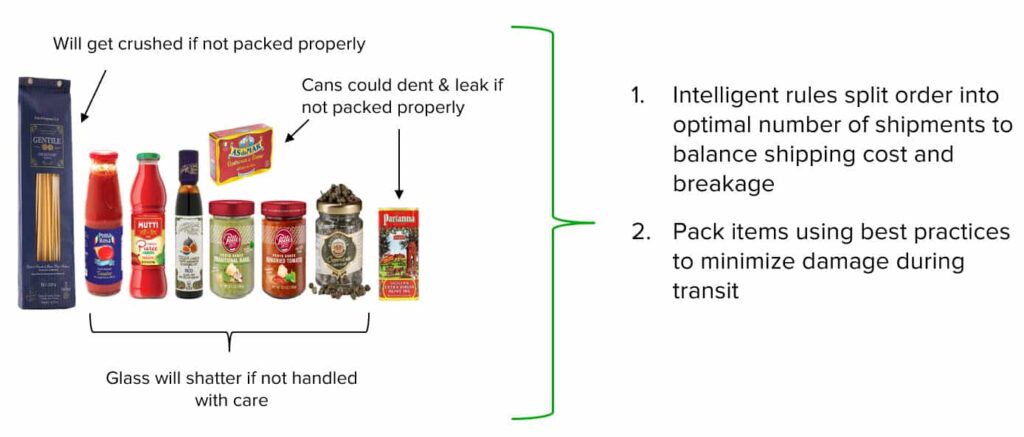
An intelligent shipping software will make the difficult feasible by splitting the order into a number of shipments that finely balances shipping cost and breakage risk. It will then give guidance to the packing station on how to precisely protect and package each item to fit into the smallest box that will prevent damage in transit.
Many warehouses are set up for peak speed and efficiency, and thus, they don’t have the flexibility to intelligently adapt to different types of goods that need different treatment. That’s where Cahoot sets itself apart.
Future Trends in Warehouse Picking
The world of warehouse picking is constantly evolving, driven by technological advancements, changing consumer demands, and global economic shifts. Some of the future trends in warehouse picking include:
- Adoption of Artificial Intelligence: Artificial intelligence is expected to play a larger role in warehouse picking, automating tasks, and improving efficiency. AI-powered systems can analyze data, dynamically calculate the most efficient picking routes in real-time, considering factors like traffic, order priority, and worker location, and predict demand, enhancing overall warehouse operations.
- Increased Use of Robotics: Robotics is expected to become more prevalent in warehouse picking, automating tasks, and improving efficiency. Advanced robots can handle complex picking tasks, work alongside human workers, and adapt to changing warehouse environments.
- Growing Importance of Sustainability: Sustainability is becoming increasingly important in warehouse picking, with companies looking for ways to reduce their environmental impact. Implementing eco-friendly practices such as reducing waste and optimizing energy use can help warehouses become more sustainable.
- Blockchain for supply chain transparency and tracking: Using blockchain technology to track items throughout the supply chain with up to the minute status and location.
- Increased Focus on Customer Satisfaction: Customer satisfaction is becoming increasingly important in warehouse picking, with companies looking for ways to improve delivery times and fulfillment accuracy. Enhancing the picking process through technology and best practices can help meet customer expectations and drive business growth.
By staying ahead of these trends and continuously improving their picking processes, warehouses can ensure they remain competitive and meet the evolving needs of their customers.
Scale Faster with the World’s First Peer-to-Peer Fulfillment Network
Tap into a nationwide network of high-performance partner warehouses — expand capacity, cut shipping costs, and reach customers 1–2 days faster.
Explore Fulfillment NetworkCahoot: The Best Pick and Pack Fulfillment Service
Cahoot’s nationwide network of over 100 warehouses provides affordable national ecommerce order fulfillment for online merchants. Our wide and diverse network enables us to fulfill a wide variety of needs, from sellers who need absolute peak speed at minimum cost to those that have fragile items or others that require special handling.
Our fulfillment centers are outfitted with dedicated personnel and technology that confers all the benefits of a top pick and pack service:
- Efficient picking enables late (2pm local time) order cutoffs
- Barcode scanning all but eliminates fulfillment defects
- Intelligent pick and pack software optimizes box size for every order, minimizing shipping cost for simple and complex orders
- Lowest cost by design
Unlike other providers, Cahoot also has the flexibility to work alongside existing merchant-owned warehouses (if you have them). We know that many merchants with non-standard items and order profiles carefully manage fulfillment themselves due to how difficult the process can be. Cahoot will analyze your existing network and customer base, then add a few locations of our own to seamlessly extend your network into a nationwide footprint.
With this approach, you can continue to get value out of your existing assets while delighting your customers and your bottom line with affordable fast shipping. Of course, our approach works just as well for merchants who want to fully outsource their fulfillment, and we’d be more than happy to take that on. Getting started with Cahoot is fast and easy – with pre-built integrations for major ecommerce channels like Amazon, Walmart, Shopify, and BigCommerce, we can get merchants started in as little time as it takes to send us your inventory. Talk to one of our experts today and explore how we can be the key that unlocks the next level of your profitable ecommerce growth.
Frequently Asked Questions
What is warehouse picking?
Warehouse picking is an order fulfillment process where item(s) from a customer order are retrieved from their inventory location(s) in a fulfillment or distribution center such as in a bin or on a shelf or pallet. Warehouse picking is the step that occurs before products are packaged and shipped out to their destination.
What is the picking process in a warehouse?
Warehouse picking is the process of finding items within a warehouse or fulfillment center and preparing them for shipment to customers. But there’s a lot of different ways to go about warehouse picking to ensure that it’s done as effectively and efficiently as possible.
What do you do as a warehouse picker?
Warehouse pickers are responsible for finding, picking, and packing goods for dispatch. They work in various locations, including e-commerce warehouses, wholesalers, and cold storage warehouses. It’s a physically demanding role that involves bending, lifting, and carrying products.
How to do picking in warehouses?
There are many strategies for picking in warehouses, which include batch picking, wave picking, zone picking, and piece picking. The best strategy for your warehouse picking setup will depend on the order volume running through your warehouse, the total number of SKUs in storage, your total number of pickers working at the same time, the type of facility you have, and the inventory management system and other technologies you have at your disposal. The different picking methods each have their own advantages and drawbacks.
What is voice picking in a warehouse?
Voice picking is a method of warehouse picking where pickers are equipped with a headset and microphone so they can easily communicate with the warehouse manager about picking details. Some systems are connected with an automated management system, which eliminates the need for a human on the other end of the line. Similar to other wearable warehouse picking options, voice picking has proven to be a time-efficient method and it also cuts down the likelihood of picking errors.

Turn Returns Into New Revenue

